One of the most daunting things when I first started looking for a gun was deciding what size bullet to get.
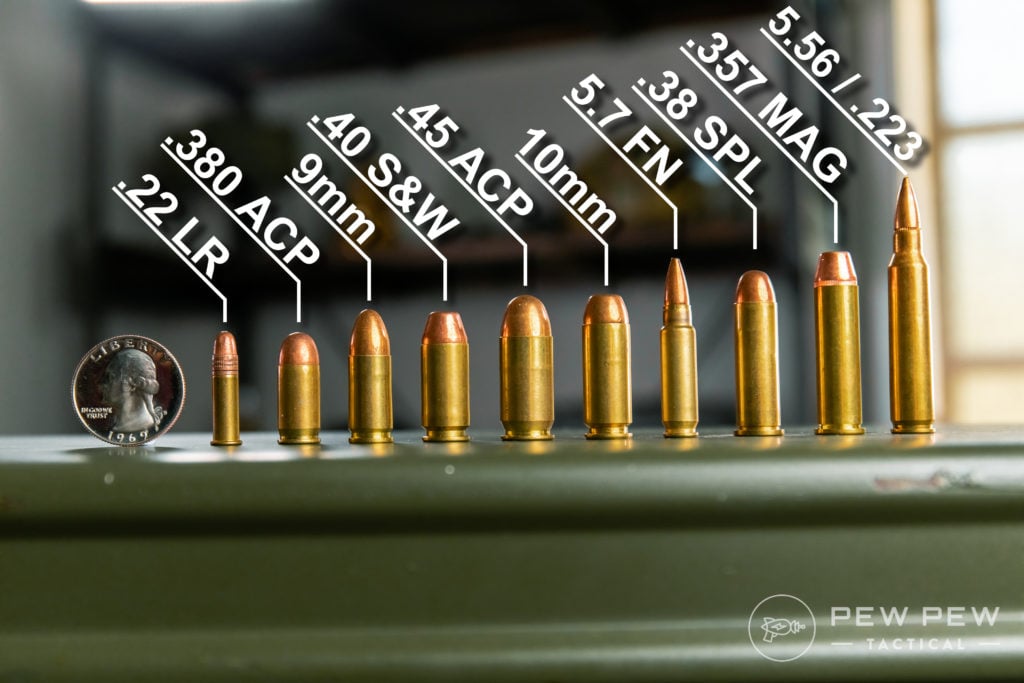
Things got even crazier when I started to look at rifles…
But don’t worry, we’ll be covering some of the most popular handgun, rifle, and shotgun calibers out there and going over the benefits and weaknesses of each.
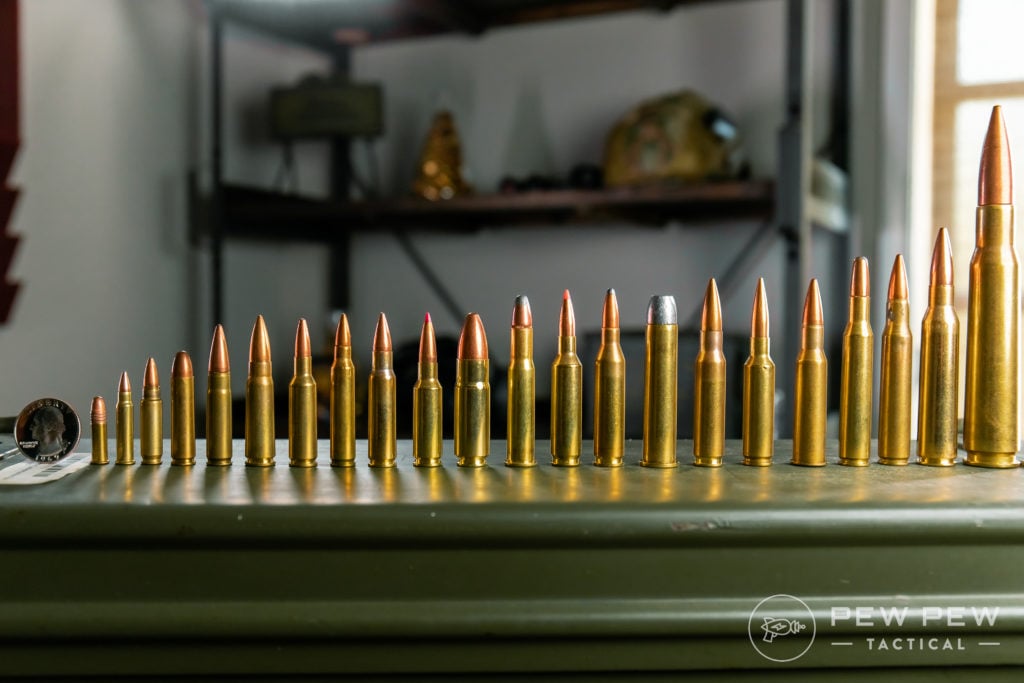
Then we’ll follow up with some bullet terminology and the different types of bullet tips (hollow point, etc), how shotgun shell sizes work, and a breakdown of the components of a round.
By the end, you’ll be a bullet pro!
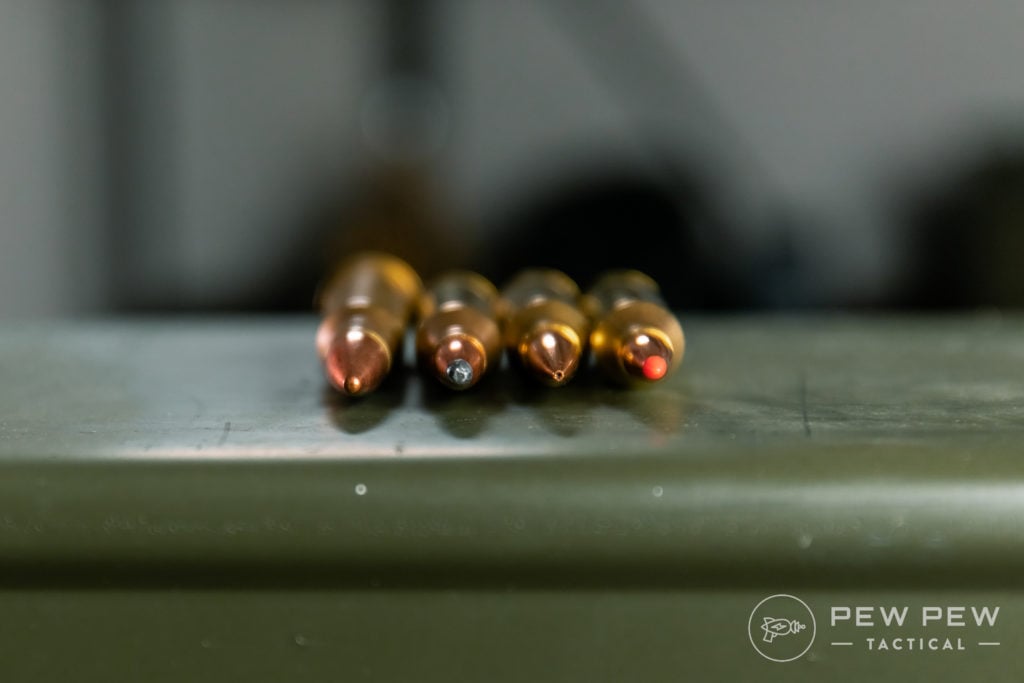
Table of Contents
Loading…
Bullet Size & Caliber
For guns, “caliber” means the diameter of the barrel and, thus, the diameter of the bullet that is going through it. Usually in inches or mm, like 9mm for pistols and .223 for rifles.
Also, for terminology’s sake, “bullet” just means the metal projectile, while the entire thing is called a cartridge.
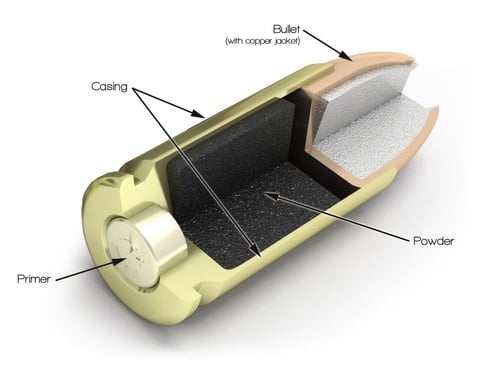
Rimfire vs. Centerfire
The first differentiator is between rimfire and centerfire cartridges.
The rimfire’s primer is built into the rim, while the centerfire cartridge has the primer in the center. Pro tip: If you can see a circle in the middle, it’s a centerfire cartridge.
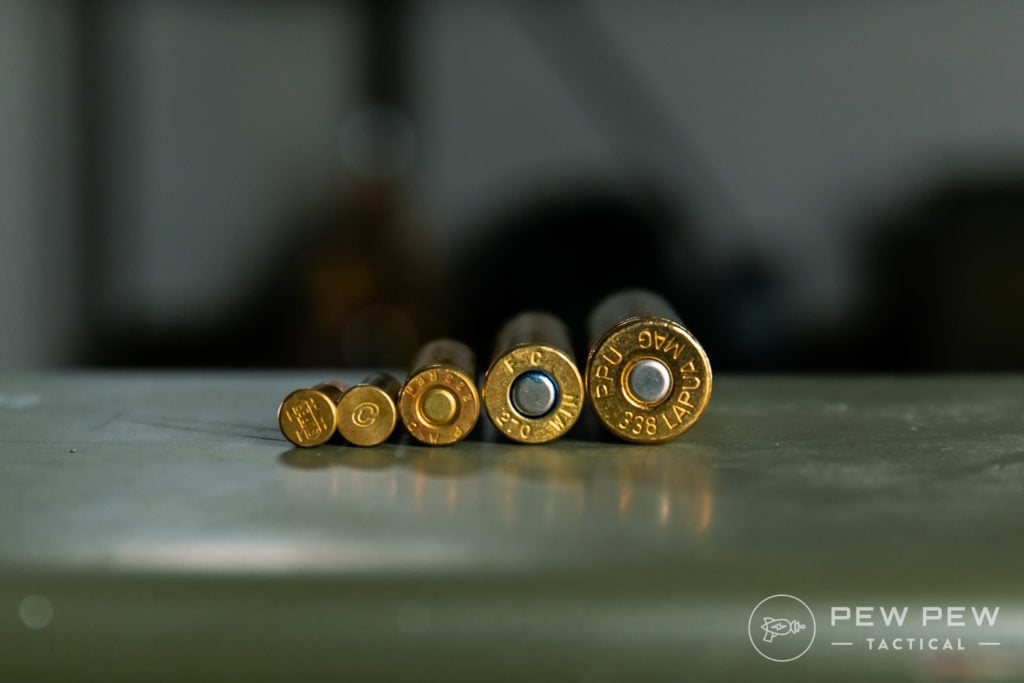
Rimfires are extremely cheap (a few cents each), and the .22LR is the most popular rimfire caliber.
This animation shows how the firing pin hits the primer in a cartridge.
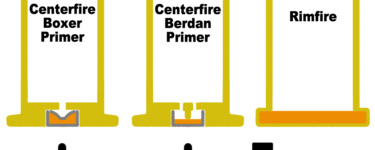
Here are some expended casings from a rimfire vs centerfire. You can see the primer strikes on the rim for the rimfire and the center for centerfire.
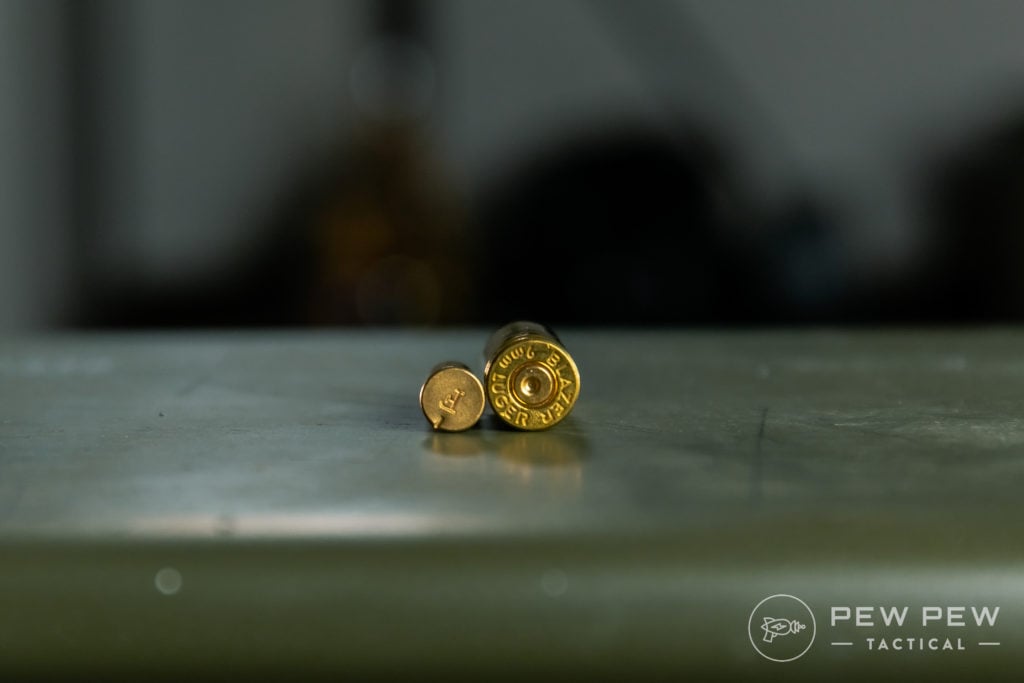
For even more differences, see our article on Rimfire Ammo or familiarize yourself with How Guns Work.
Common Bullet Calibers
To make things a little more confusing, there’s a mixture of measurements in inches and millimeters.
There’s also a unit of weight called a “grain,” which is used to denote the weight of bullets and gunpowder. A “grain” is really small since 7,000 grains make up one pound.
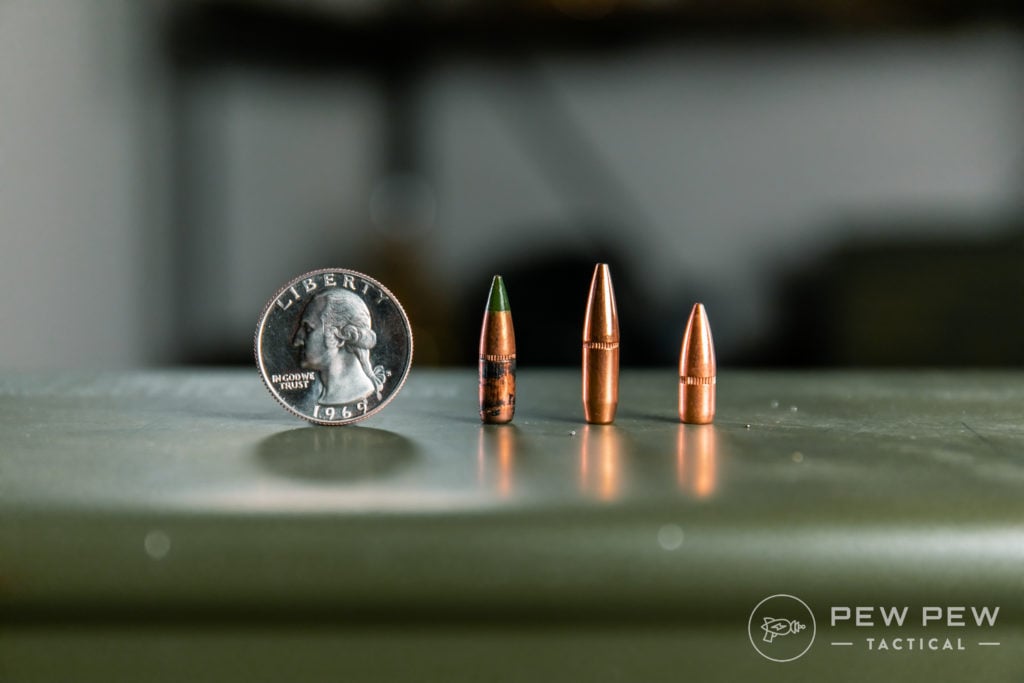
Now, let’s go through some rounds!
1. .22LR
Pros
- Affordable
- Very little recoil
- Great for plinking and critters
Cons
- Not great for self-defense
The “twenty-two” long rifle is the most common caliber in terms of units sold.
It has a bullet weight of around 30 to 40 grains and is extremely mild shooting in both pistols and rifles.
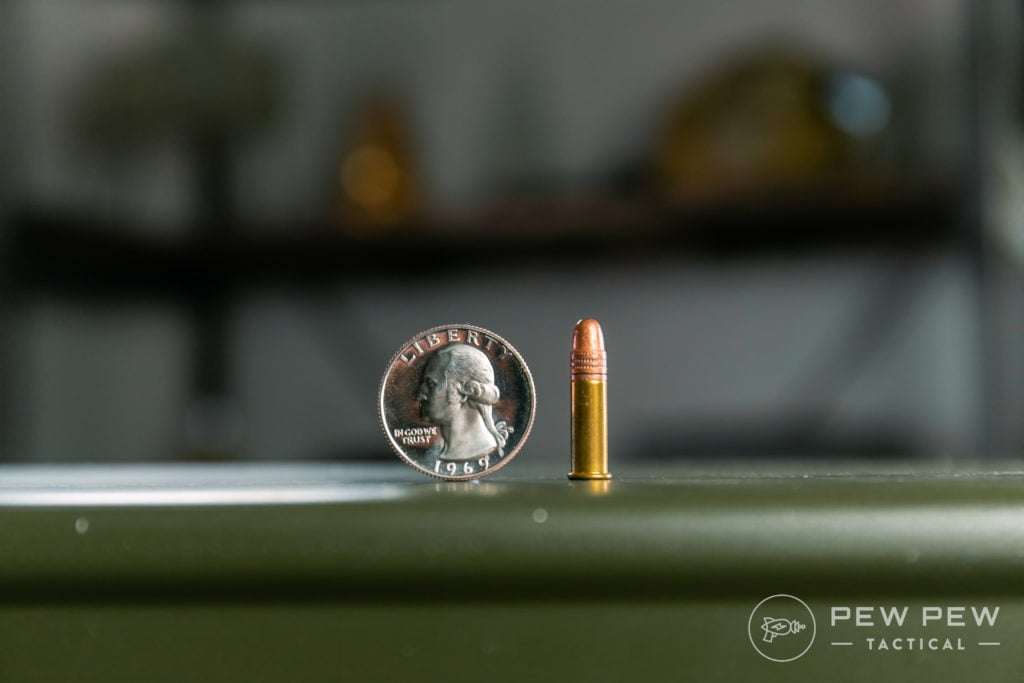
The recoil is almost non-existent, which makes it a great starter round for someone who has never shot a gun or is uncomfortable with the noise.
The low price of the bullets is also great for learning sight pictures.
It is traditionally the starting caliber for shooters. These things are only a few steps up from a pellet gun round, especially in a rifle (Ruger 10/22) shown below.
They’re mostly for taking care of rats, snakes, and birds. They’ll be useful for self-defense, but it might take a shot or six.
For more info:
2. .380 ACP
Pros
- Adequate for self-defense
- Low recoil
- Smaller handguns
Cons
- Could have more oomph for defensive use
- Many of the guns chambered in .380 can be harder to shoot due to their size
Now we’re getting into slightly beefier sizes.
Personally, I would never use a gun with anything smaller than a .380 as my primary carry weapon.
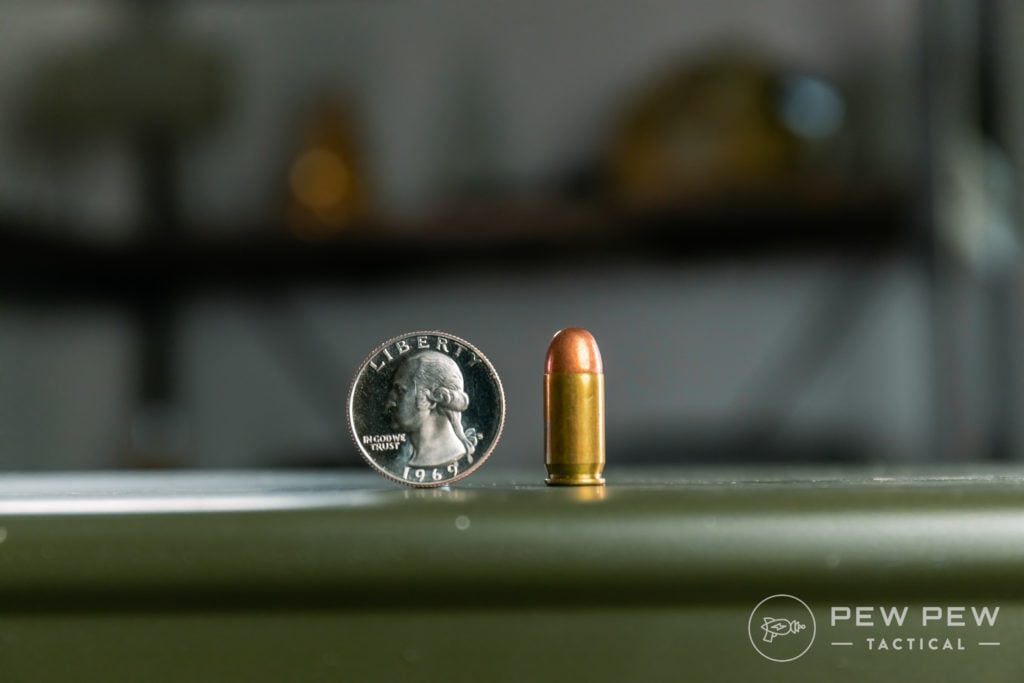
Sometimes called a “9mm Short”, it has seen a major boost in popularity recently thanks to the various “pocket pistols” that have come on the market.
This bullet has relatively low recoil and, at close range, good penetration.
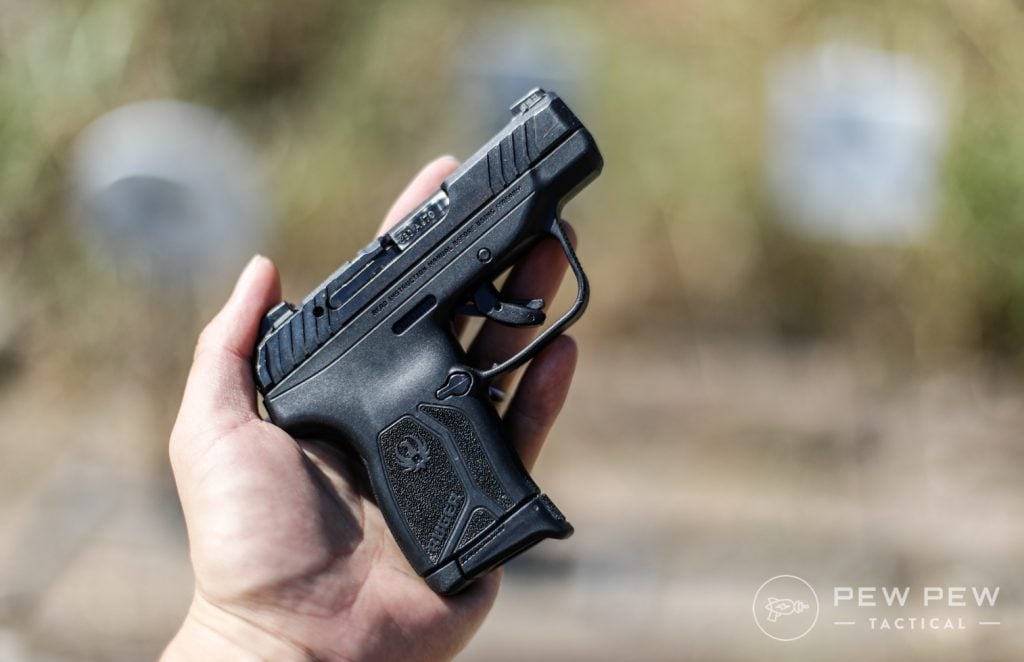
Gun author Massad Ayoob once said of the .380, “Some experts will say it’s barely adequate, and others will say it’s barely inadequate.” This is a low-power round.
Because of the nature of the bullet and the guns that shoot it, its effectiveness is relatively limited beyond close-ish range, even with good defensive rounds.
For more info:
3. 9mm Luger
Pros
- Good for self-defense
- Affordable
- Lots of different bullets and loads
- Good capacity handguns
Cons
- None
This pistol round is officially known as the “9x19mm Parabellum” or “9mm Luger” to distinguish it from other 9mm rounds. But you will be fine just saying “nine millimeter” or “nine mil” for those in the know.
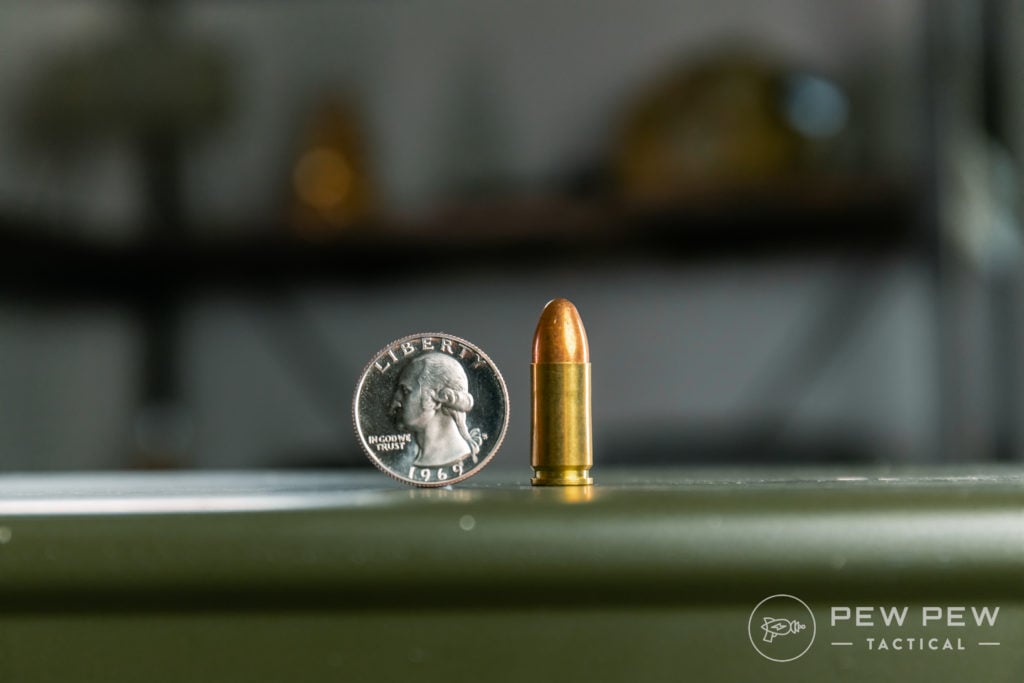
9mm is my personal favorite, and if there were a “Goldilocks” round, this would be it.
They’re fun at the range. They’re good for defense.
Believe it or not, the 9mm bullet is the same diameter as the bullet used in the .380 and the .38 Special.
The difference between the three is the amount of gunpowder behind it and the bullet weight.
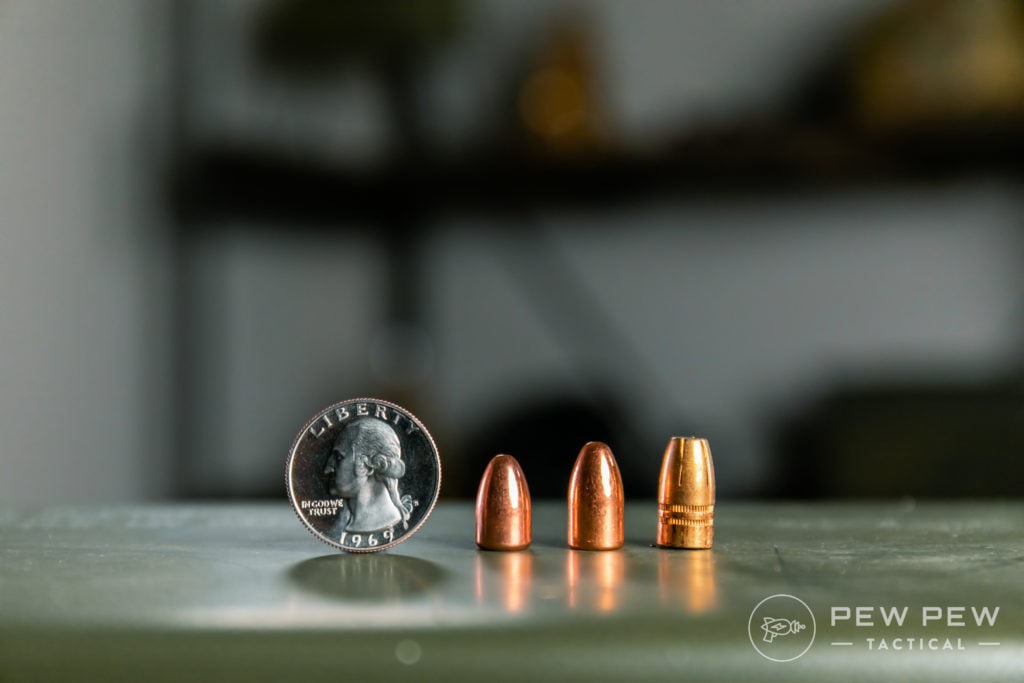
It is the standard round for NATO countries and the majority of police forces around the world.
It is mild shooting, can vary in weight from 115 to 147 grains, and has varying stopping power based on the type of bullet (hint: go with hollow points).
Many, many guns use this size as well. A compact 9mm gun can be used for concealed carry. Most of the guns that use this size can hold, on average, 15 to 17 rounds in the magazine.
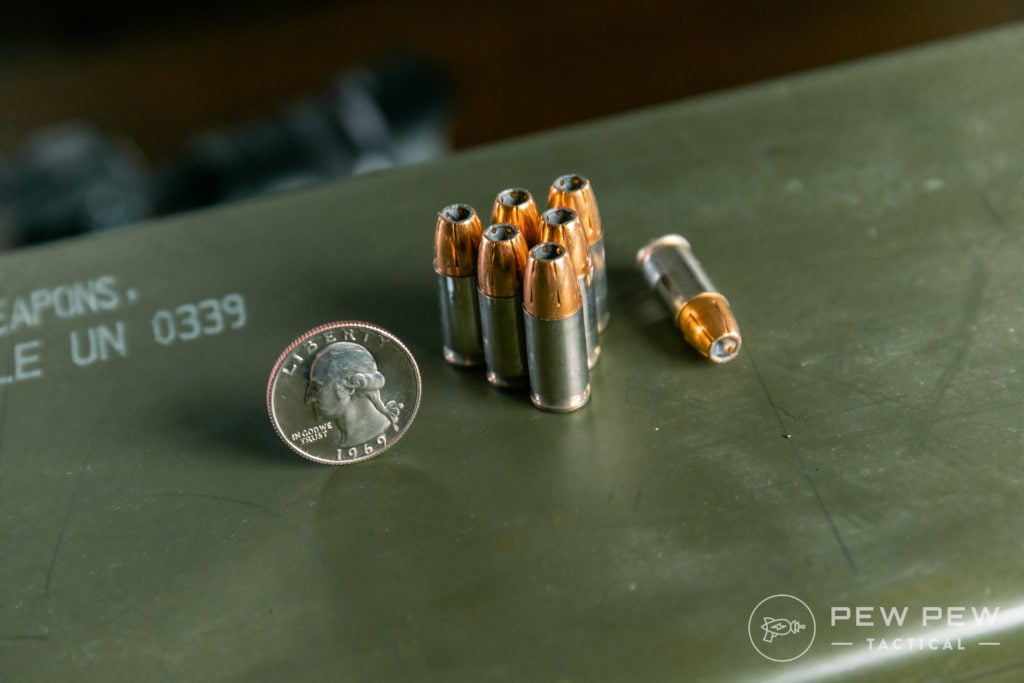
And now, there’s been a huge rise in the popularity of Pistol Caliber Carbines (or PCC). Get the nice ergonomics of a rifle but with the price and hollow points of the 9mm.
For more info:
4. .40 S&W
Pros
- More power than 9mm
- Lots of affordable LE trade-in guns available
Cons
- Snappier recoil
- More expensive than 9mm
- Lower capacity than 9mm
Remember how I said the 9mm was the “Goldilocks Round?” If that’s the case, then the .40 is her big, angry, whiskey-drinking sister.
Originally designed for the FBI as a reduced 10mm cartridge and has been popular with other law enforcement agencies ever since.
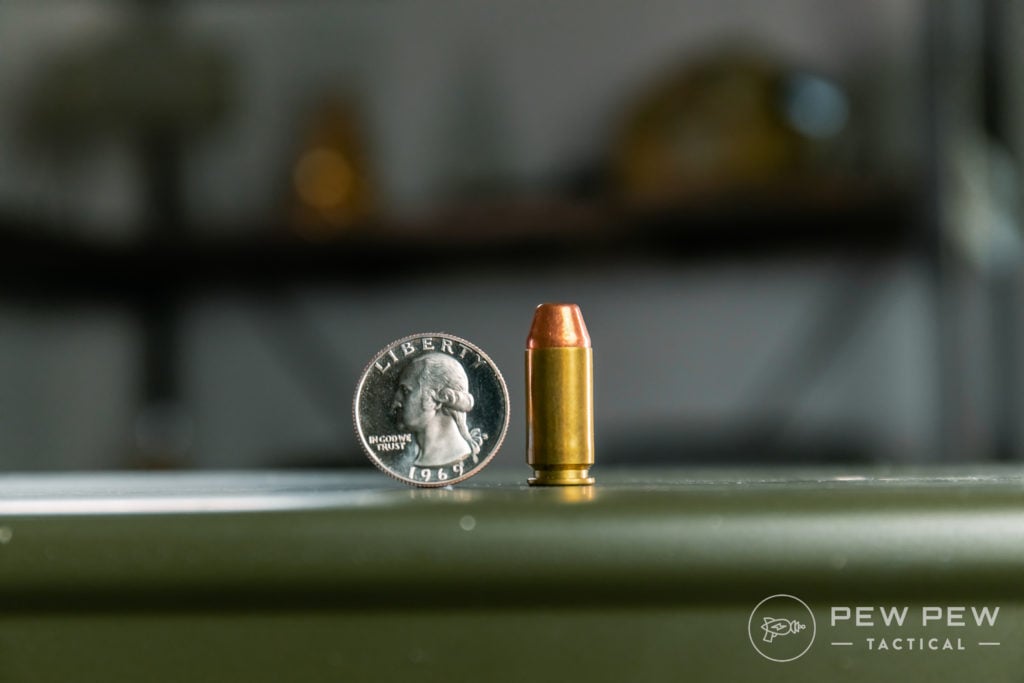
It has more kick when compared to the other popular handgun cartridge, the 9mm. Weights typically vary from 155 to 180 grains, although some specialty rounds will fall outside that range.
It is worth mentioning that the FBI recently decided to move back to the 9mm since agents are able to shoot more quickly and more accurately with 9mm compared to the .40 S&W.
Many other law enforcement agencies have followed suit, as has the general public. This has led to a pretty steep decline in the popularity of .40 S&W in recent years.
For more info:
5. .45 ACP
Pros
- Big heavy round
- 1911 nostalgia
Cons
- Lower capacity guns
- More recoil
Designed in 1904 by Mr. John Browning himself for the famous 1911 pistol, this round has one heck of a history.
This thing is a big bullet with stopping power to spare.
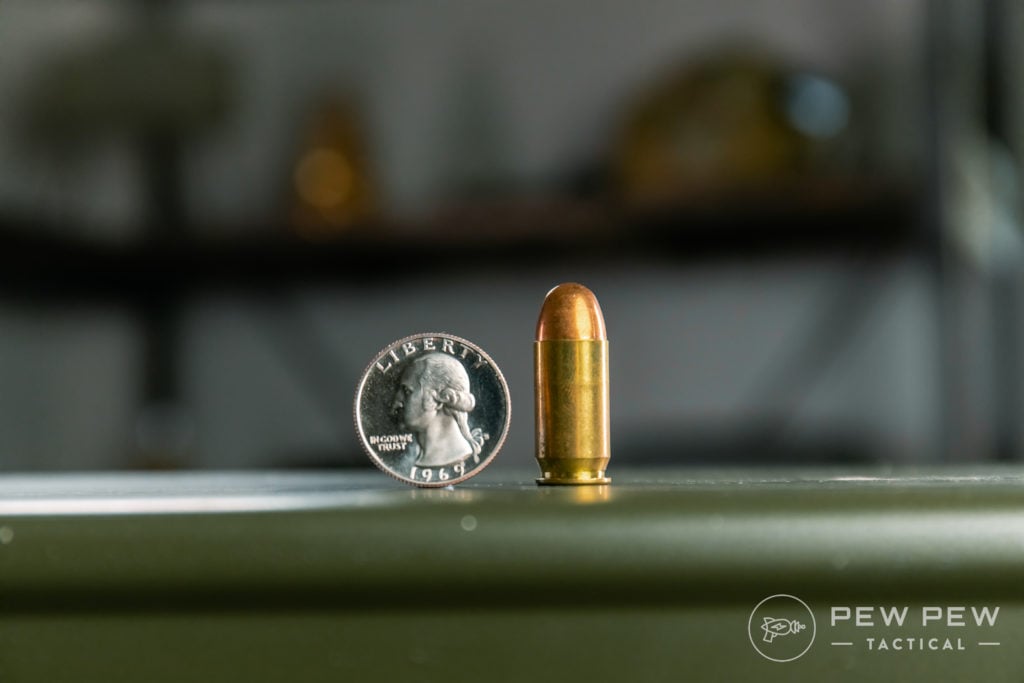
The choice of many police officers and military personnel for years, the .45 caliber round has proven itself time and time again. I could probably do an entire article on just this bullet.
It has a large bullet of around 230 grains and has moderate recoil.
I can tell you from personal experience that this is not a round to hand to someone who’s never fired a gun before. Its stopping power is renowned, and it has a nostalgic fanbase.
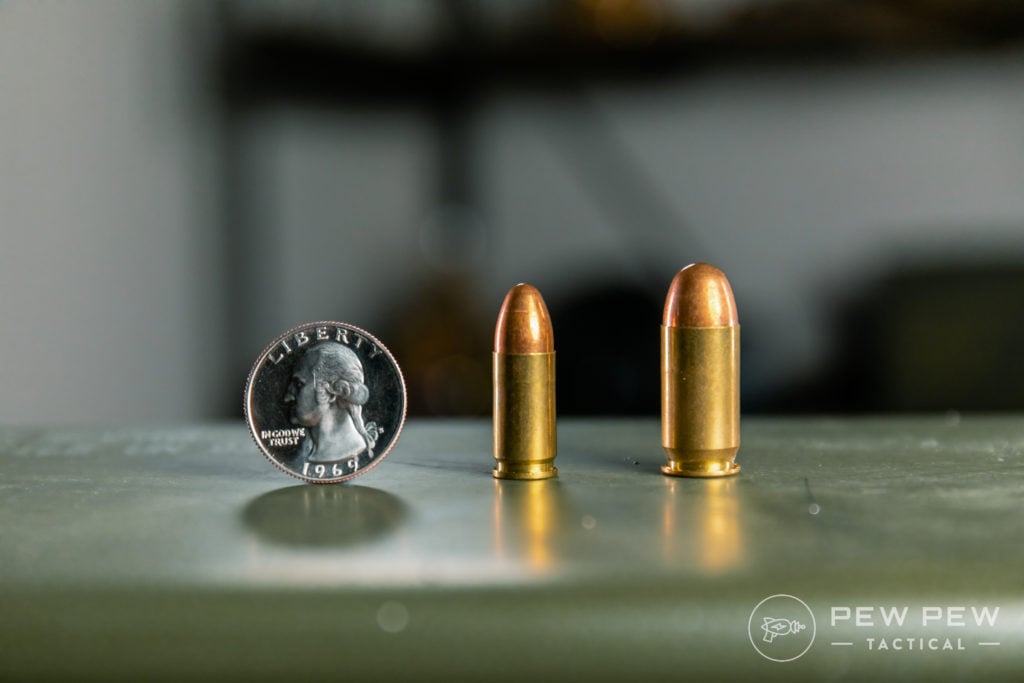
For more info:
6. .38 Special & .357 Magnum
Pros
- Most common revolver calibers
- Good effectiveness
- Lots of bullets and loads
Cons
- Not for use in most semi-autos
The “thirty-eight special” is most commonly found in revolvers.
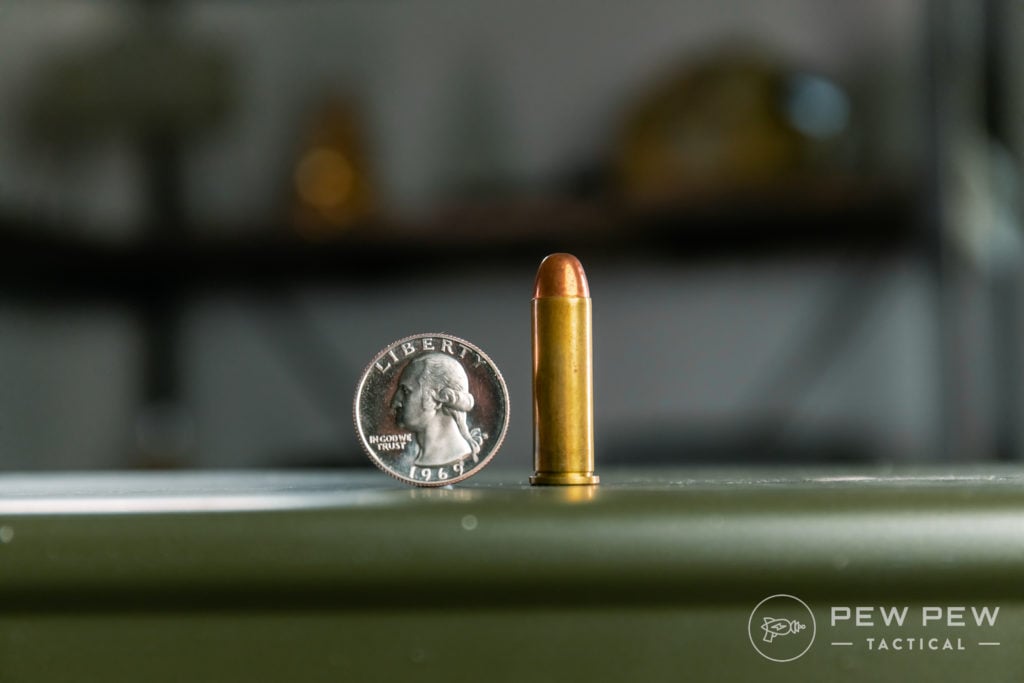
It has manageable recoil but is still quite a handful when in a very light/small revolver. It has a longer cartridge and more powder in said cartridge, but it is a slower, heavier bullet than the 9mm.
The FBI used this cartridge as its standard issue for a very long time.
The .357 Magnum is identical to the round except for being slightly longer.
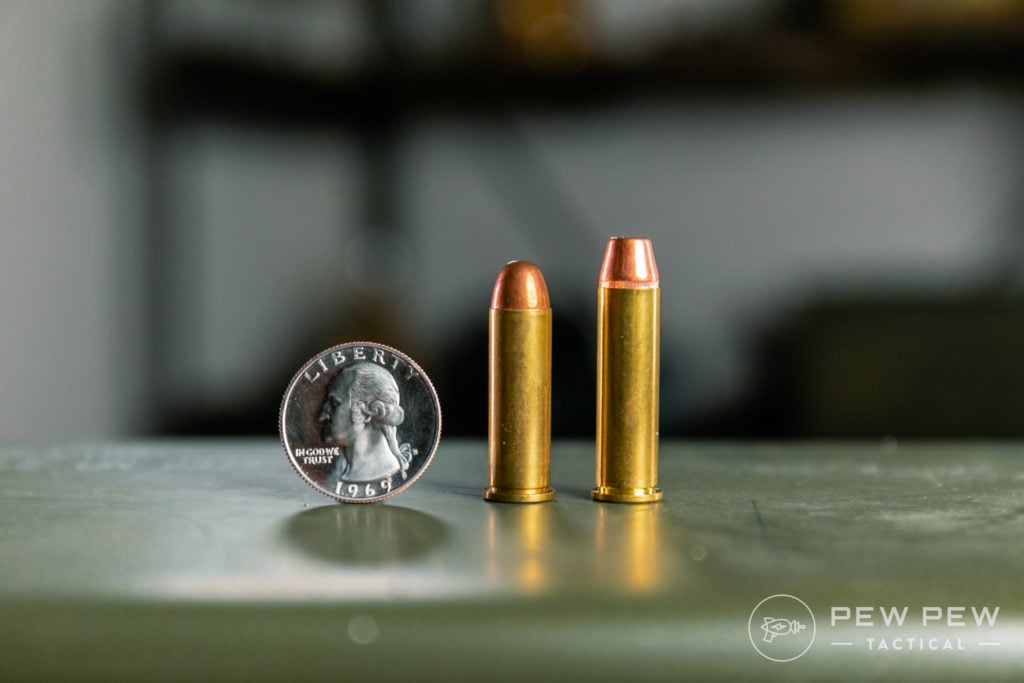
You can safely fire a .38 Special in a .357 Magnum gun, but don’t try the other way around due to size and pressure constraints.
Bullet weights typically range between 110 and 158 grains.
For more info:
7. 7.62x39mm
Pros
- Standard AK round
- Solid stopping power at normal combat ranges
- Common
Cons
- More recoil than 5.56
- Surplus has dried up
This is the Soviet round used in the standard AK-47 line of rifles.
It has moderate recoil and good knockdown power. The bullet weight is usually 123 grains or very close.
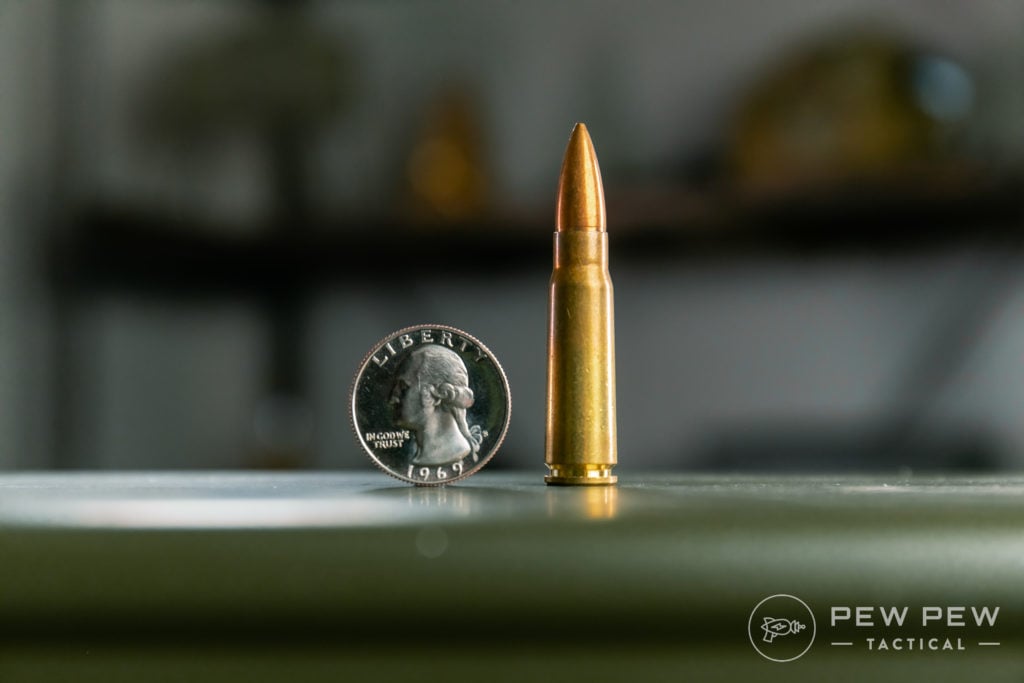
There used to be a high availability of military surplus ammo, which made the rounds very affordable. This led to an increased popularity of the round, and a few other manufacturers started chambering guns in this caliber as a result.
However, due to dwindling surplus supply and import sanctions, 7.62x39mm has increased notably in cost over the last five or so years. Despite this, it still remains a favorite of shooters due to the growing number of quality AKs available on the market.
For more info:
8. .223 Remington / 5.56x45mm NATO
Pros
- AR-15 standard round
- High velocity
- Light recoil
Cons
- May be to small for some applications
The “two-two-three” (inch) Remington has almost the exact dimensions as the “five-five-six” (mm) NATO cartridge.
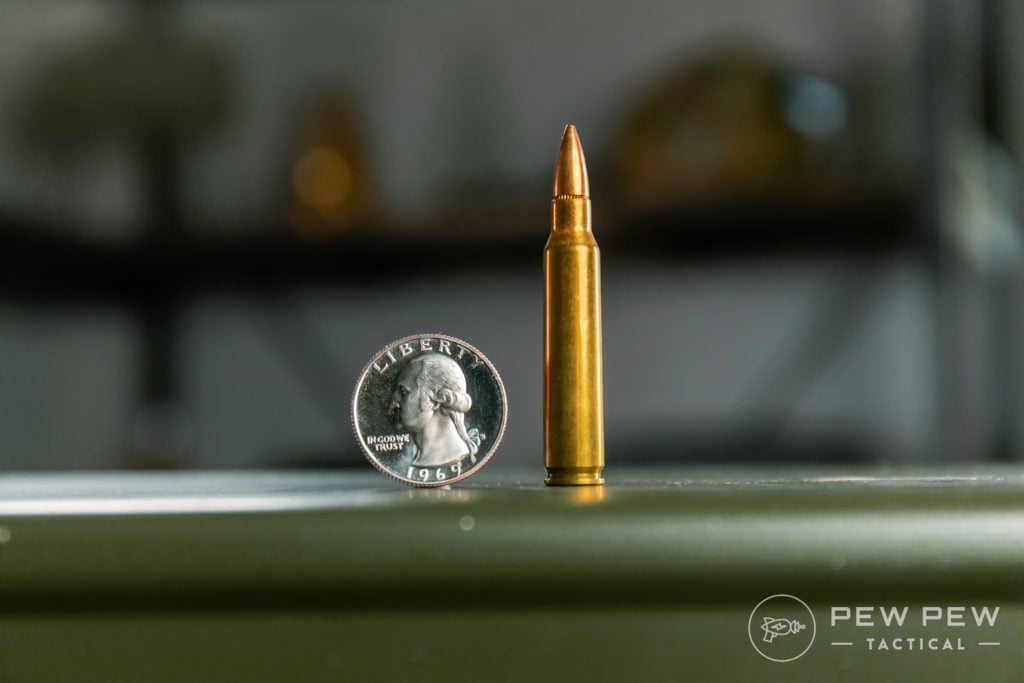
The 5.56 usually has slightly higher pressures than the .223 Remington, but both rounds are interchangeable in most modern rifles (~1990 and newer) unless otherwise specified.
Bullets are usually between 40 and 77 grains, with 55-grain rounds being the most common. The 5.56 cartridge is known for its light recoil.
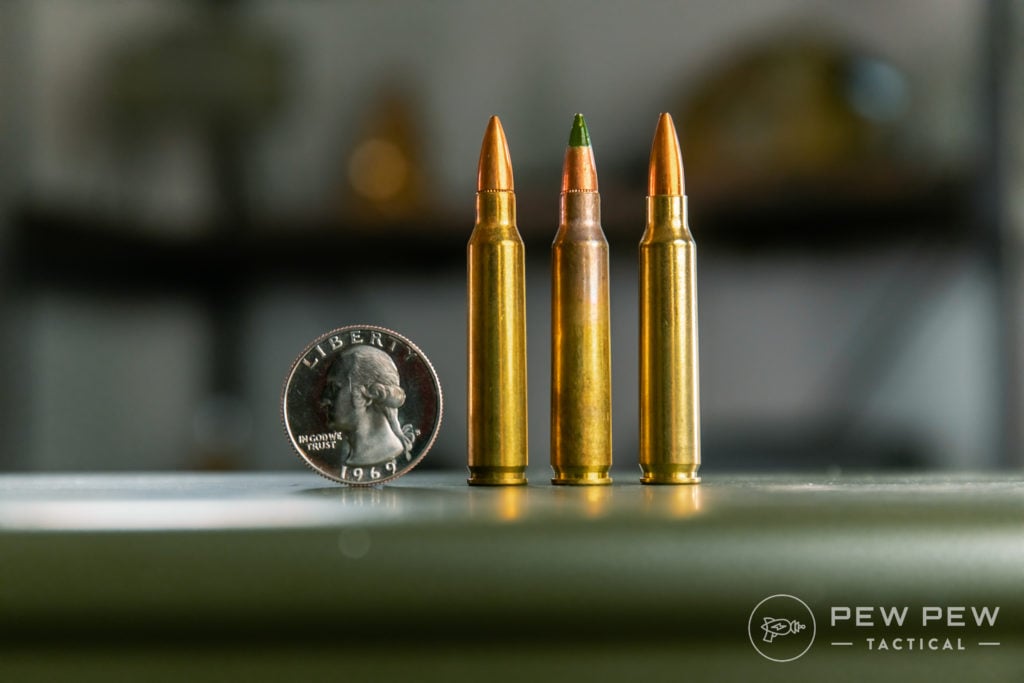
It is the ammunition used in the standard M16/M4/AR-15 line of rifles, making it one of the, if not the most popular, centerfire rifle cartridges today.
For more info:
9. .308 Winchester / 7.62x51mm NATO
Pros
- Great stopping power
- Excellent all-purpose cartridge
- Inherently accurate
Cons
- Heavy recoil
- Higher price
The “three-oh-eight” (inch) Winchester is almost the same dimensions as the “seven-six-two” (mm) NATO round.
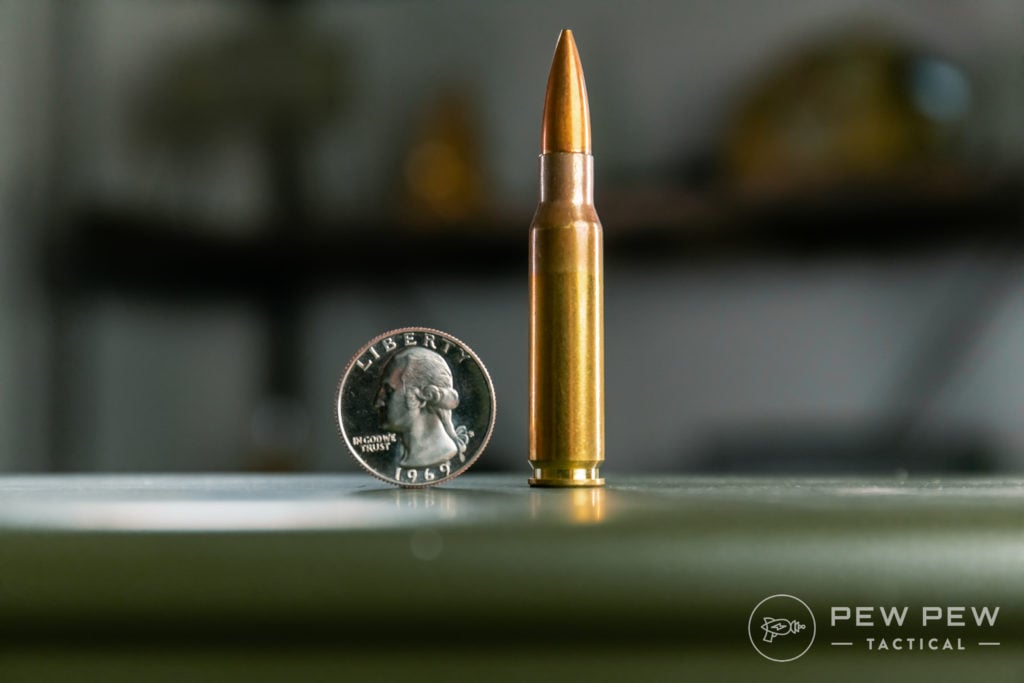
There are special considerations when mixing the rounds, but unless you know what you are doing, stick with the round intended for your rifle.
It is a popular hunting round with moderate recoil, high stopping power, and a wide range of bullets available from 110 to 220 grains.
Plus, it is one of the most popular heavier caliber machine gun and sniper rounds for many militaries and law enforcement agencies around the world.
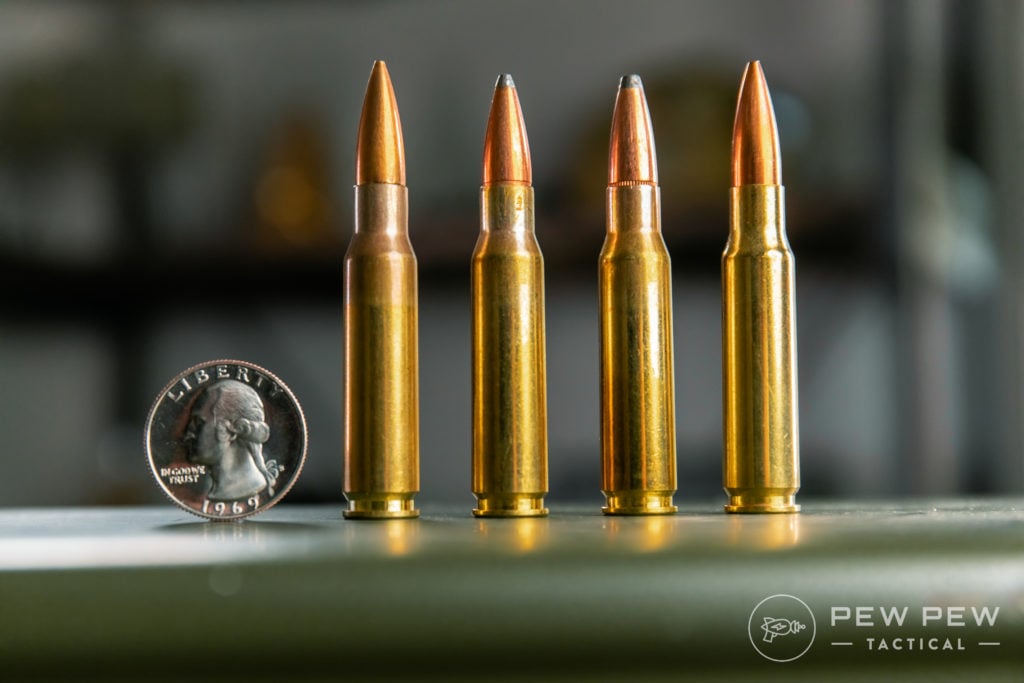
For more info:
10. .50 BMG
Pros
- Massive stopping power
- Extreme range capabilities
- It's the .50 BMG
Cons
- Harsh recoil
- Expensive rounds
While .50 BMG is not really common for civilians, we had to add it in here due to its fame and cool factor.
It is a common round for heavy machine guns and anti-material rifles, as well as specialty long-range sniper rifles. It has been seen use in everything from small arms to tanks to airplanes, and has been in use since 1921.
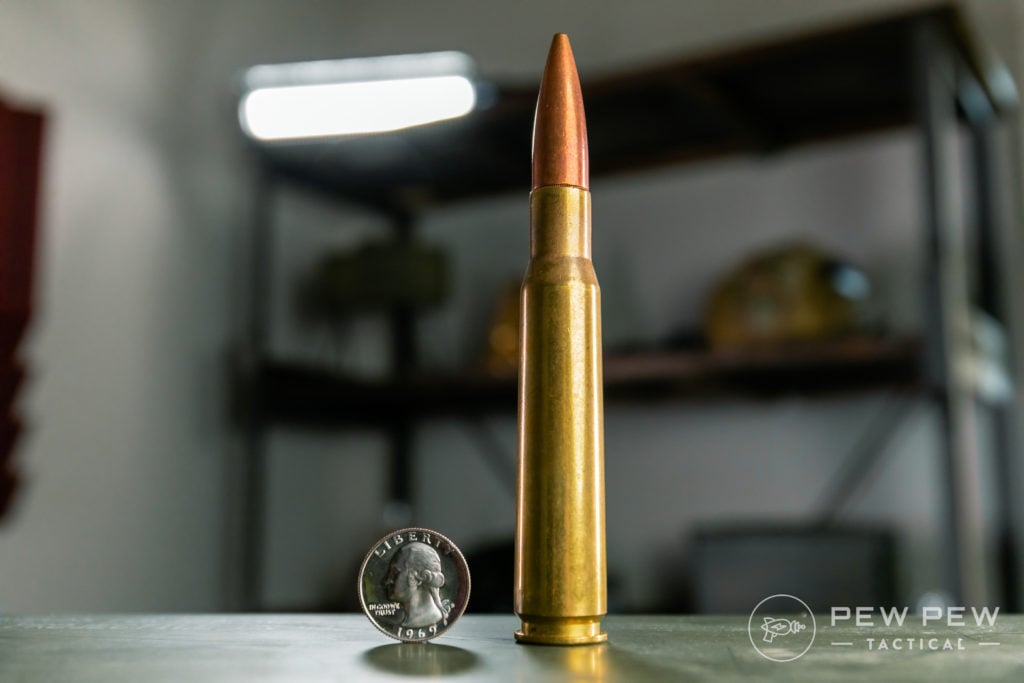
It’s huge and has huge recoil with awesome range (confirmed kills at 2,000+ meters). You definitely don’t want to be on the receiving end of this bullet and its 660 grains of pure stopping power.
This Barrett was OK because I was standing, and it had a suppressor!
Still with me?
Common Bullet Types & Terminology
Full Metal Jacket (FMJ)
This is the most common type of bullet and consists of a soft metal core, such as lead, fully encapsulated by a harder metal, such as copper.
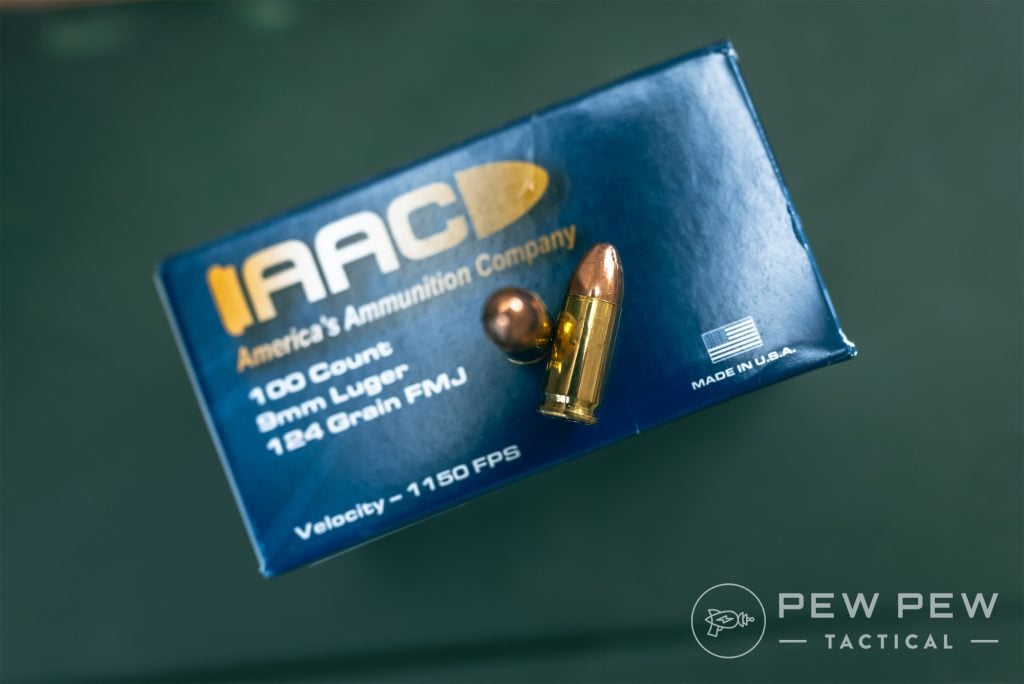
They are usually pointy, round, or even flat. Wound channels are typically small and go through a target.
While they are the go-to and great for general range use, they are not well-suited as defensive rounds.
Hollow Point (HP)
Hollow points, often referred to as Jacketed Hollow Points (JHP), are rounds with hollow tips that are made to expand once they hit something.

They are the go-to round for police officers, concealed weapon carriers, and home defense guns because of their increased effectiveness against live targets.
Open Tip Match (OTM)
Open-tip bullets may look like hollow points since they have a small opening at the top, but don’t be fooled. The openings are too small to expand effectively.
Regular FMJs are created from small copper cups where the bottom of the cup becomes the tip of the bullet. Open-tip bullets are the opposite, with the bottom of the cup becoming the bottom of the bullet.

The small opening at the top on these bullets is called a meplat and is used to help stabilize the bullet in flight. This manufacturing process creates a more consistent round than regular FMJ rounds. These small differences can be important when you’re shooting at long distances.
Ballistic Tip
This is what you get when you combine the aerodynamics of an FMJ with the stopping power of a hollow point. This is a hollow point covered with (usually red) plastic to mimic the profile of an FMJ.
They are mostly used in hunting, precision shooting, or self-defense.
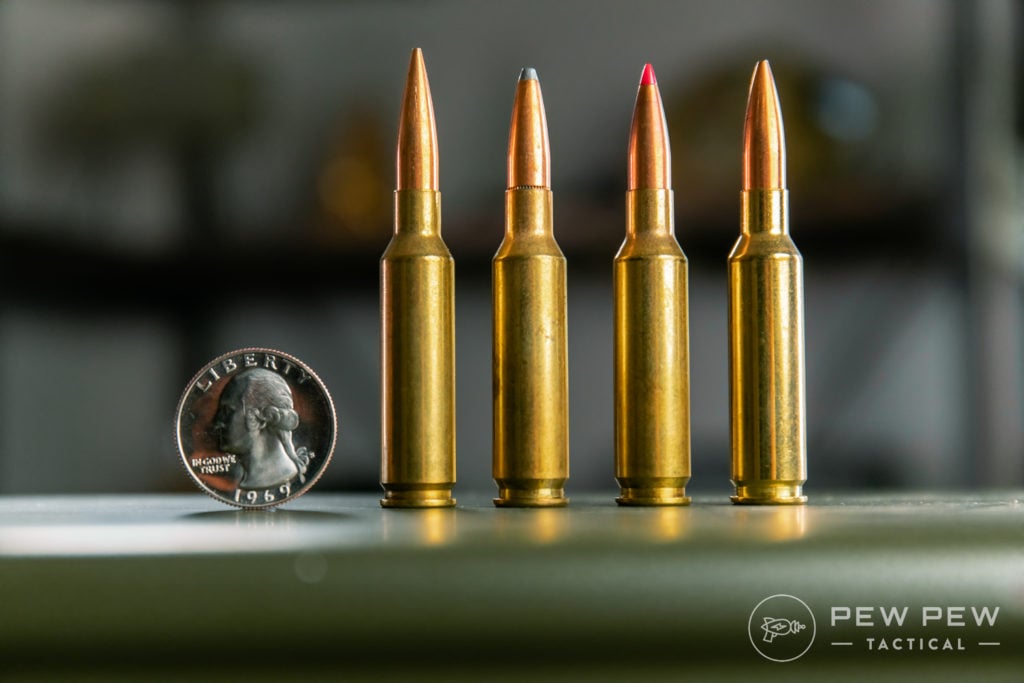
Below, you’ll see that the bottoms of the bullets are more streamlined. This design is called “boat tail” and produces less drag as the bullet flies through the air. HPBT is short for “hollow point boat tail.”
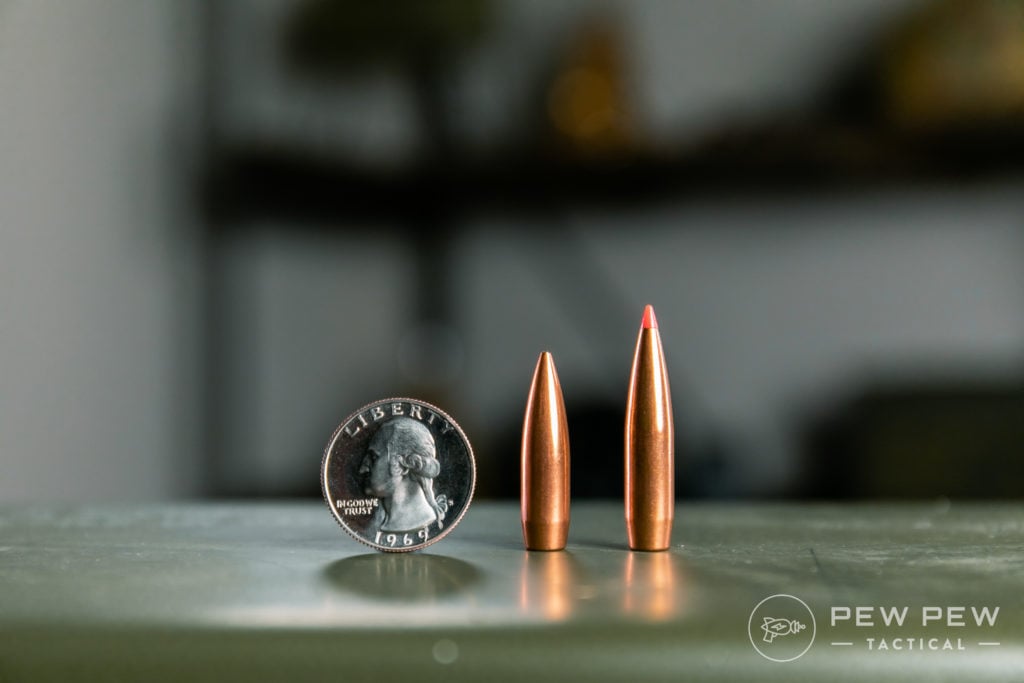
Soft-Point
Soft-point bullets also mimic the profile of an FMJ while offering better expansion.
These rounds have part of the lead exposed at the tip. The softer lead is designed to flatten better when the bullet hits a target.
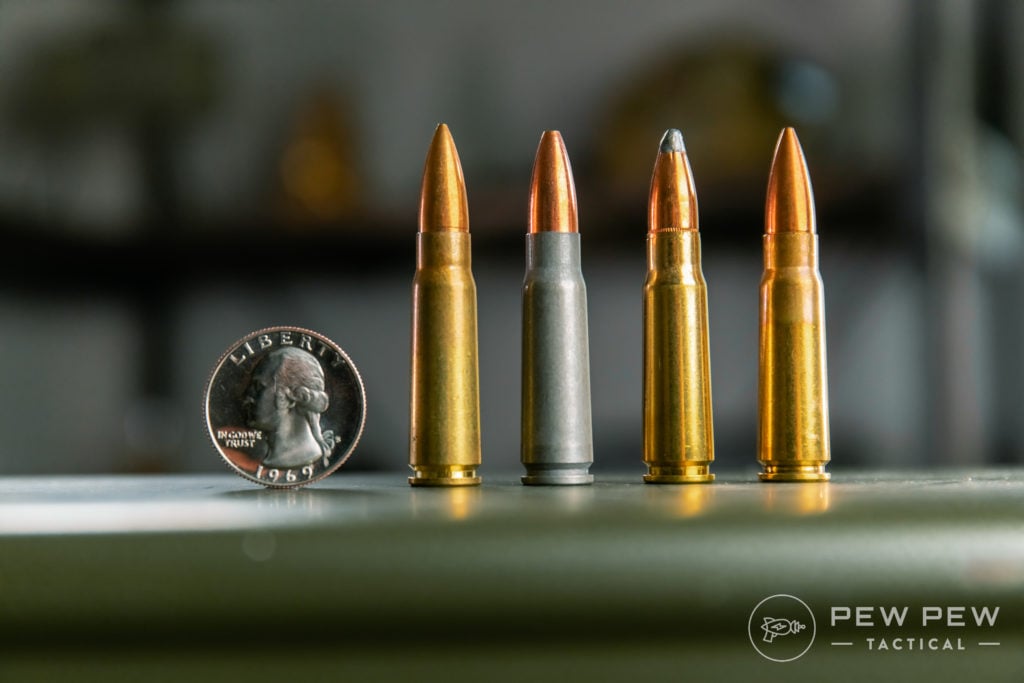
They are mostly used in hunting applications, although some defensive rounds still use soft-point bullets.
But for the most part, ballistic tips have surpassed the performance of soft points. The hard plastic tip deforms less during manufacturing, storage, and feeding over the softer, exposed lead.
Common Shotgun Ammo Types
Without a doubt, shotguns are the most versatile guns out there — and they have versatile ammo to match.
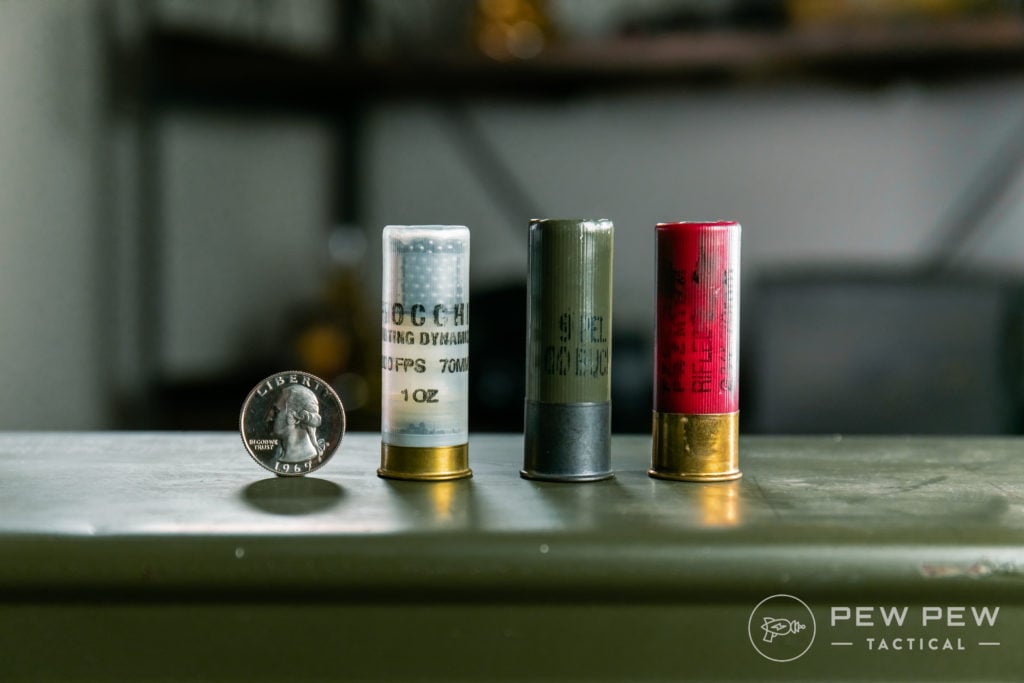
There are all sorts of crazy speciality rounds for shotguns, but by far, there are three types that are the most common.
Birdshot
Birdshot consists of a large number of pretty small pellets, numbering in the dozens in each shell. The terms “lead-shot” and “steel-shot” are also used to commonly refer to birdshot.
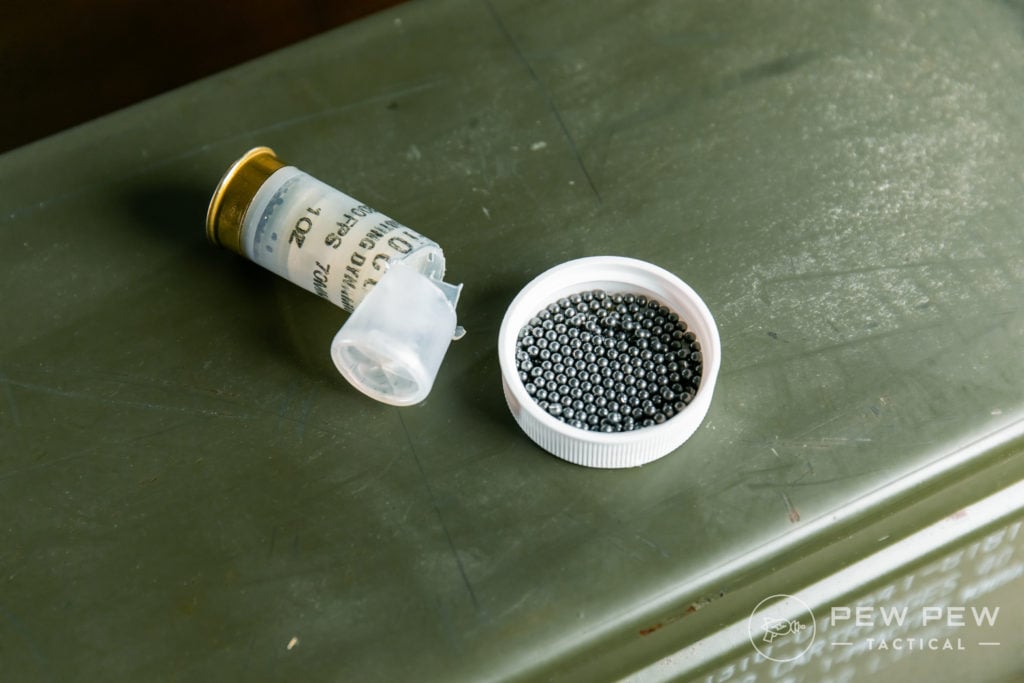
As the name implies, they are great for hunting birds, target shooting, and blasting clay pigeons due to the sheer amount of pellets and spread you get.
However, these pellets are small and lack stopping power for anything other than very small game. This means they make for poor defensive rounds despite the large number of pellets.
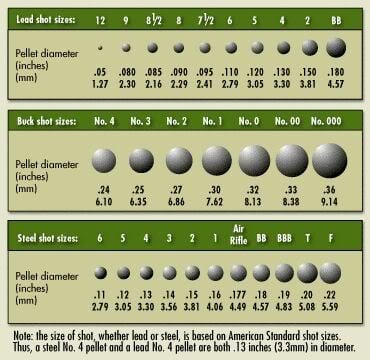
Most birdshot has lower recoil than buckshot, although some magnum loads for larger birds like turkey and geese can still have considerable amounts of recoil.
Buckshot
Buckshot is the most common shotgun round when it comes to defense usage.
The overwhelming majority of defense rounds are going to be 00 Buck (“double-aught buck”), which uses .33-caliber pellets.
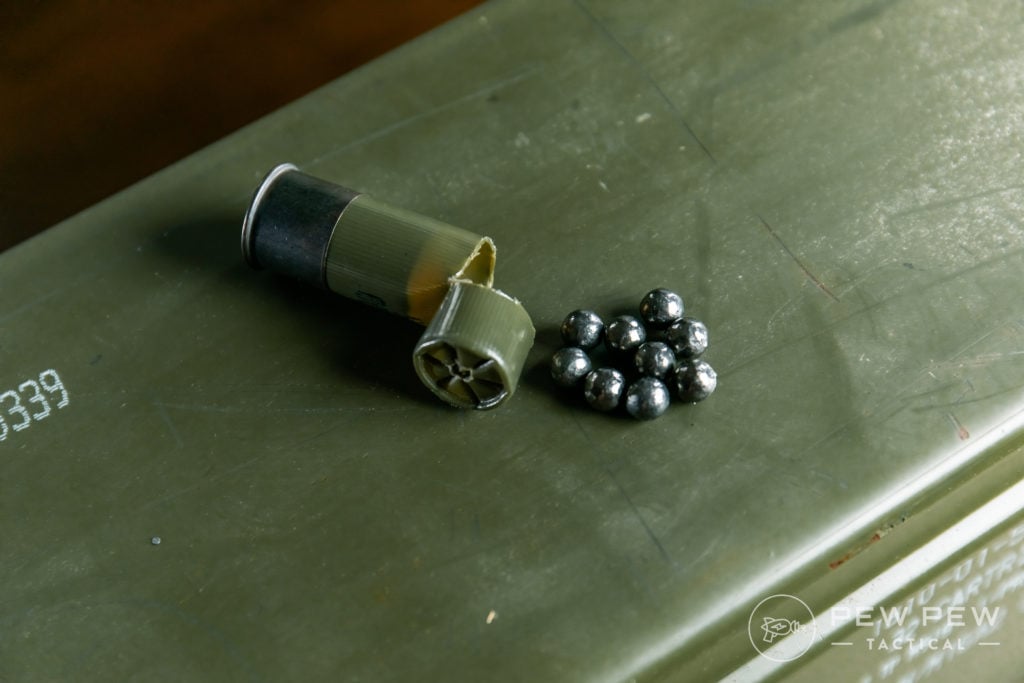
Depending on the load and size of the shell, most 00 Buck has 8-18 solid lead pellets that are each nearly the same diameter as a single 9mm round.
These rounds usually have much more recoil than birdshot, but you can also find reduced-recoil buckshot rounds, as well as buckshot that is smaller than 00 in size.
Slugs
Slugs are typically 7/8 to 1 1/4 ounce single solid metal projectiles that really bring the hurt.
However, they don’t have the spread of birdshot or buckshot. But, in the hands of a solid shooter, they can be accurate up to 100 yards.
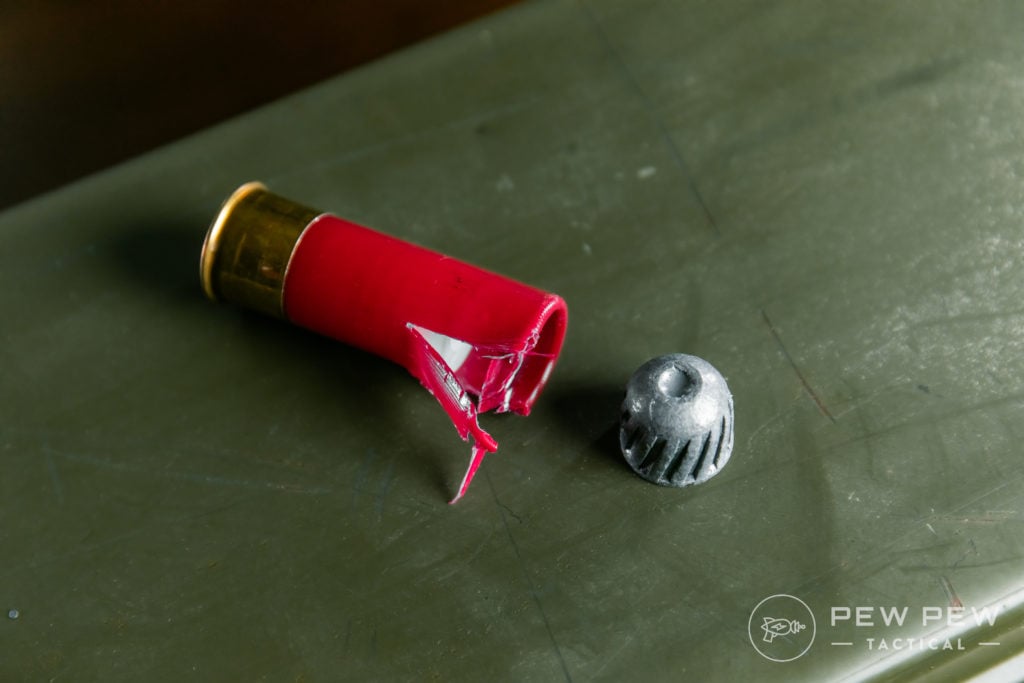
Slugs are typically more suited to hunting applications where a lot of energy and slightly more range and accuracy is required.
While some people elect to use them for self-defense purposes due to their sheer power, it should be done so with caution, as they require more precision and are prone to extreme over-penetration.
For more info:
Components of Common Cartridges
What makes up a cartridge?
- Bullet: This is the actual projectile that is propelled through the barrel and exits the gun
- Powder: The propellant that is ignited by the primer, which then pushes the bullet forward.
- Primer: A small cap that contains a compound that ignites that when struck, ignites the powder.
- Casing: Metal casing that holds all of the components of the cartridge together.
Here are just a couple of breakdowns of super popular calibers. You can see the difference in powders & bullets for each type.
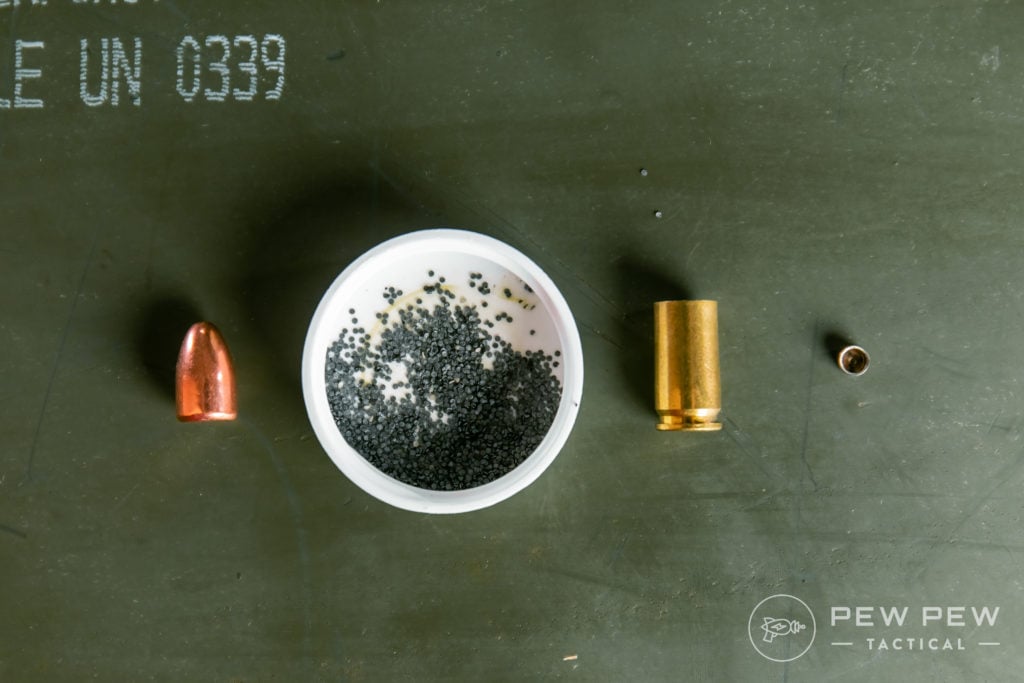
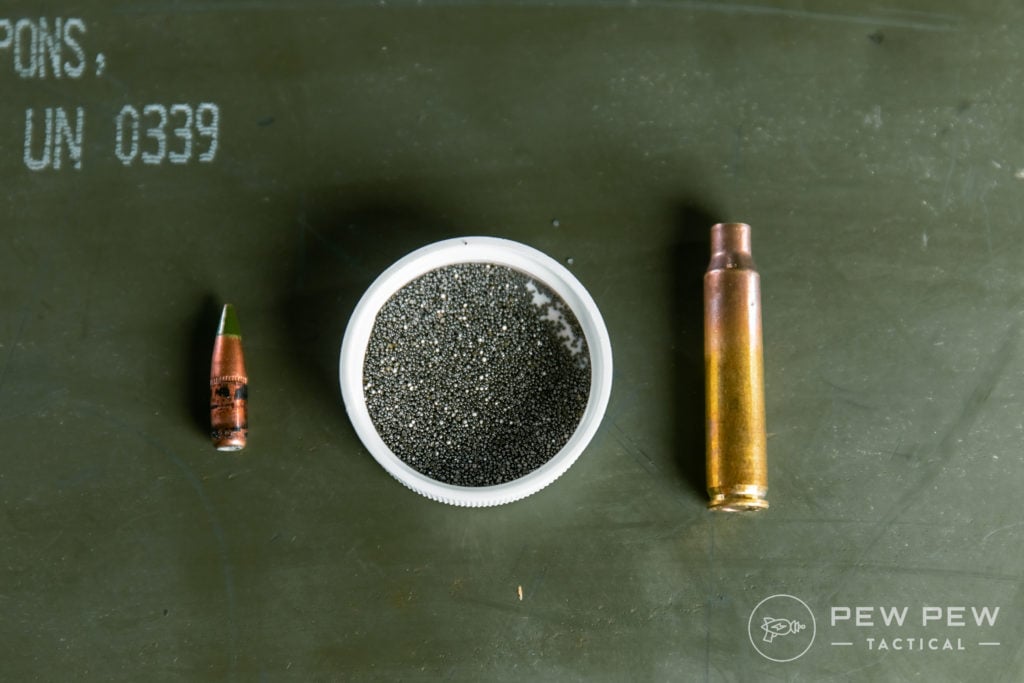
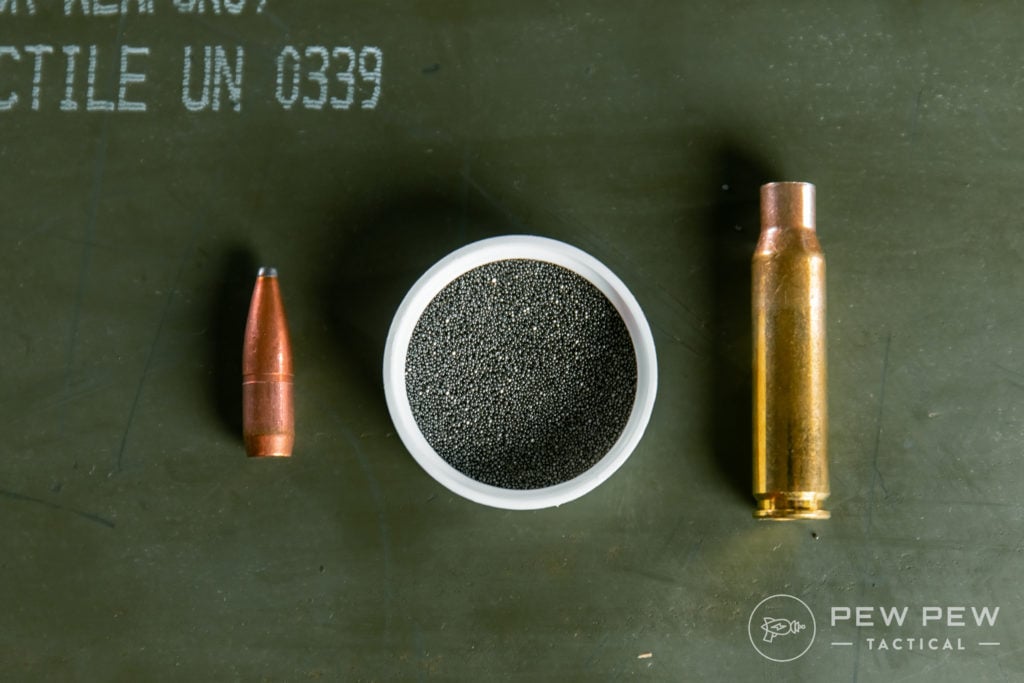
Why You Should Trust Pew Pew Tactical
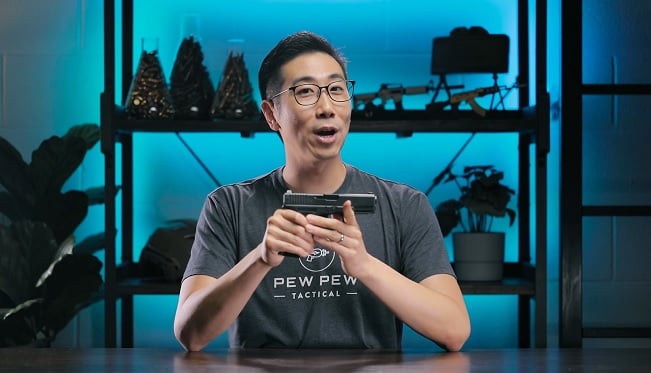
This article was written by PPT Founder and CEO Eric Hung. Eric is an NRA-certified pistol instructor and a USPSA/3-Gun/NRL22 competitor. He has also researched and written over 250 articles on firearms and gear. Over the years, he has acquired quite a few guns, as well as a small mountain of safes to test and store said guns in. He used hands-on experience to create this list.
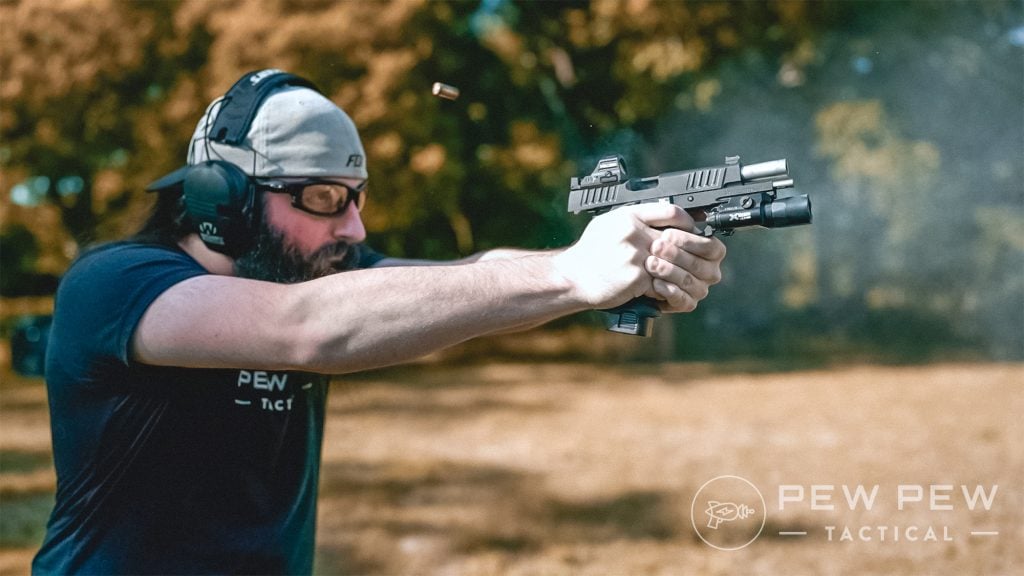
Editing and adding to this article is editor Wyatt Sloan. Wyatt is an NRA-certified instructor with previous experience as a USPSA competitor. Wyatt personally owns over 200 firearms in over 50 different chamberings and has 10 years of home-based FFL firearm sales. He has used his extensive experience with firearms to test guns and gear for Pew Pew Tactical.
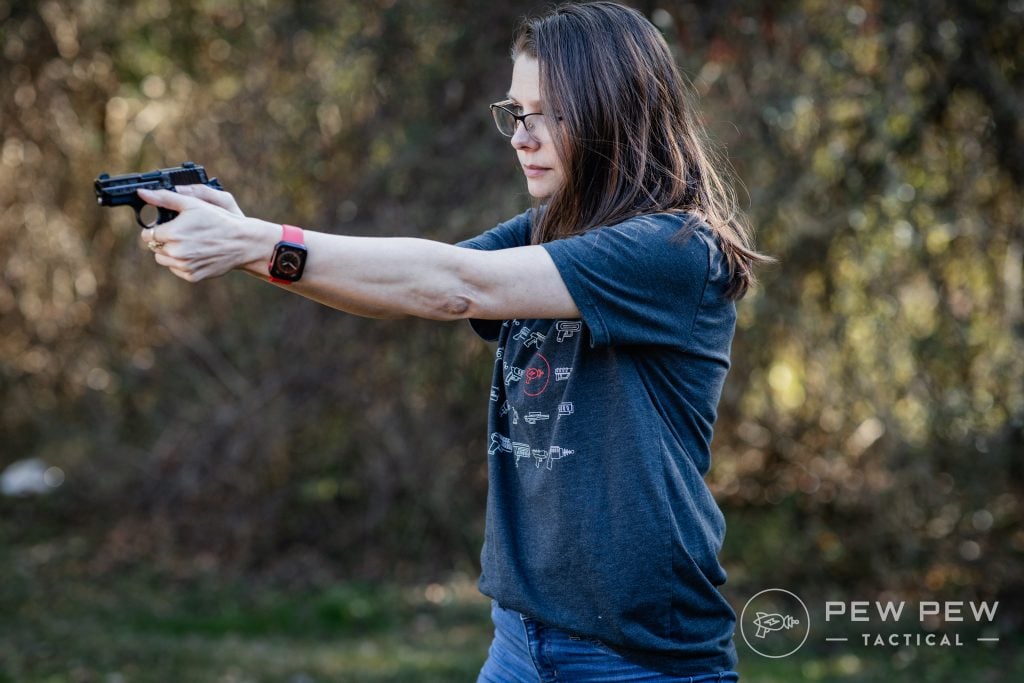
Editor-in-Chief Jacki Billings runs our experienced team of reviewers. She is a National Rifle Association Basic Pistol Instructor as well as a member of the Society of Professional Journalists, ACES: Society for Editing, and the Professional Outdoor Media Association. Jacki has a bachelor’s degree in journalism and has worked as a media professional for close to 20 years, specializing in gun media for almost 10 years. With 2,000+ articles to her name, she uses her professional journalism and editing experience to set testing protocols and editorial standards for Pew Pew Tactical.
Final Thoughts
There you have it. Now you’re a bullet pro!
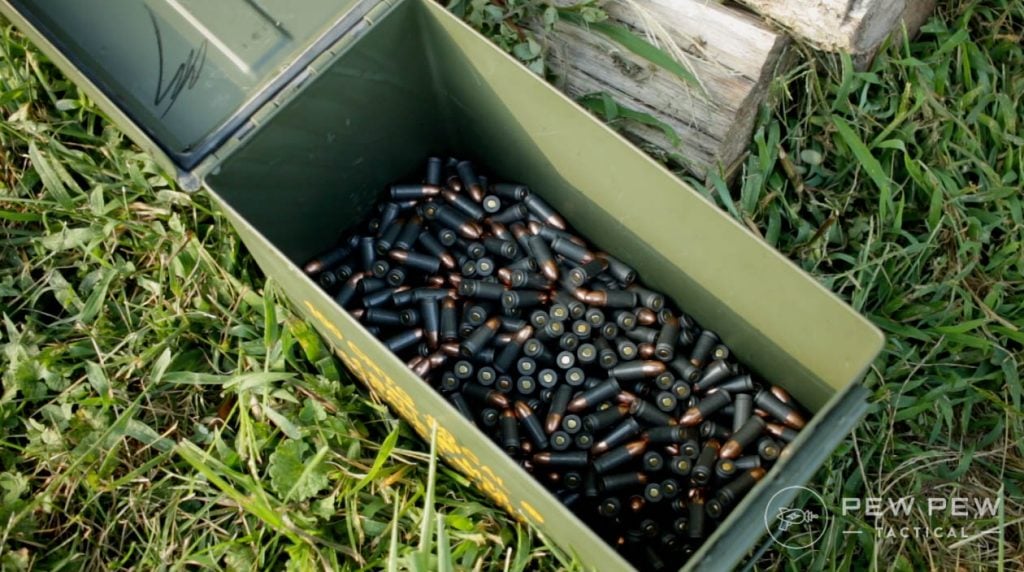
Continue on with a deeper dive into Popular Handgun Calibers, Popular Rifle Calibers, or the difference between Steel-Cased and Brass Ammo.
And if an expertly created beginner handgun course is what you’re looking for, check out our article, Gun Noob to Gun Slinger!
LATEST UPDATES
- March 2025 – Updated pros/cons. Tweaked article layout and information throughout. Additional sections added.
- June 2024 – Added pros/cons to calibers and minor tweaks throughout.

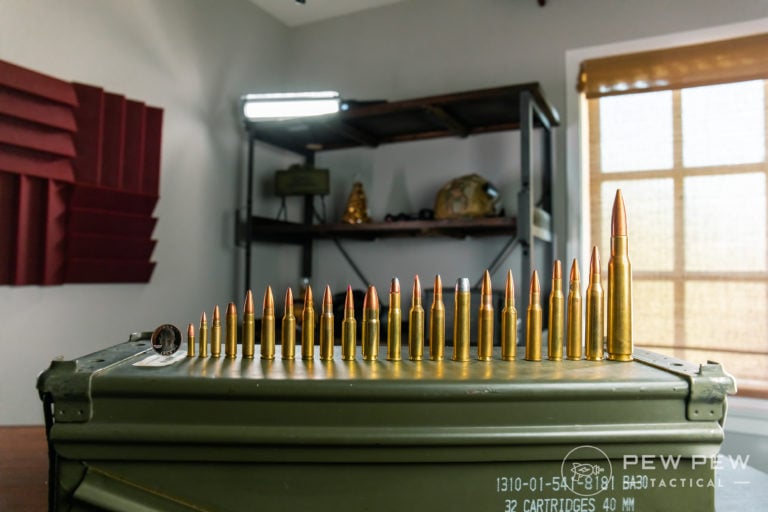
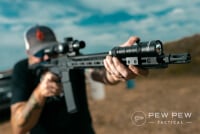

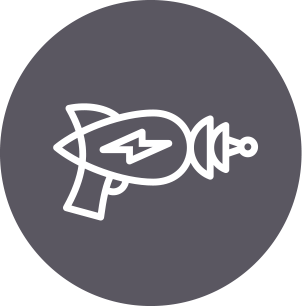




256 Leave a Reply
Always very informative and good reads. I respect the genuine expertise & hands-on aspects of reviews and articles. I make my 18 year-old gun fan read everything as it is solid training material.
Thanks.
Hey Phil! Thanks so much for reading and also using our articles to educate your kiddo. We greatly appreciate you taking the time to read and drop us a comment! You guys are the reason we do what we do here!
Good read. I also like the 10mm a lot.
Thank you very informative. Is this available in a downloadable format?
Very informative, well written
This was really useful, thank you. I am doing a science fair project on ballistics and this was really helpful.
Glad you found it helpful! Thanks for reading!
Good luck on your science fair project!
Well done sir; for me it was most informative, concise and extremely well illustrated. Keep up the good work. PJ
Ok
A quite concise. Well illustrated !
Awesome info, thank u
This was a really great read very informative!
Great collection of info!
How about adding small weapons like the baby browning, star,’ weapons that fit in your pocket are very useful. Small gun Big surprise.
Is there a reason why you didn't discuss the 10mm? Since it was developed specifically for the FBI, but then discontinued due to agents being unable to handle the power of the recoil.
It was not the recoil that was the problem; it was the ballistics pertaining to accuracy and the female agents with a smaller grip. The 40/10mm ballistics are ok but not good or great. The second, most ladies have a smaller grip range and the 40/10mm frame was not friendly to smaller hands. The 9mm has much better ballistics, accuracy, lighter recoil, and a smaller hand grip. These are the main two reasons the FBI moved back to the 9mm.
That's a lot of great information.
I might add, for 100+% larger wound cavity than HP defensive, or hunting ammo; UnderwoodAmmo offers the best there is, making it possible for those who need to go with small calibers/firearms; still remain effective.
Nice work, Eric. Even as experienced shooters, we can all use a review on this information from time to time. I definitely learned some things from this piece.
Great article, touching the key points, could be nice to have muzzle brake and sound supressor included in other blogs. Guns and ammo for hunting is my primary interests. Thanks Eric.
One thing you missed Eric. John M. Browning didn't just develop the .45 ACP, but he also developed the .25, .32, and .380 ACP cartridges (though the .25 and .32 didn't make the list). Ol' John developed the .50 BMG as well.
You've a good animated diagram of Boxer v Berdan v Rimfire Priming Systems, but you didn't point out the difference between Boxer and Berdan primers. Boxer: Single Flash Hole, Anvil in the Primer Cup. Berdan: Twin Flash Holes, Anvil in the cartridge case, and that Boxer primed cases can be reloaded, Berdan primed cases are not (or not without some real specialty tools).
Just a couple of items for your primer worthy of mentioning.
I wonder where 6.35mm Beretta and 7,62 James Bond ammo fit in the handgun bullet table. They are clearly missing.
.38 special, .357 mag NOT the me as 9mm! 9mm is typically .355-.356 inch diameter. .38/.357 is typically .357-.358 diameter. (jacketed v cast lead) Not a big deal in some loads but it is in others. I've been reloading for more than 60 years!
Yep. You're right. They're real close, but swapping one into the other can and will effect accuracy and potentially change the pressure curve as the slightly bigger bullet is forced out of the barrel slighy smaller than the bullet..
Great job on this article. Very informative and well written so anyone can understand. I am disappointed by but expected the kick back from the people that use weird or useless calibers. We must all remember this is an article not a book. It covered the basics and most popular calibers which helps people learn. Well done.
Truly a remarkable volume of info. The pix really help put things in perspective.
A very solid article indeed of the most common calibers, but so much easier to follow and learn. Outstanding explanations. Guns matter little without knowledge of ballistics, and this lays the groundwork for so much. Thanks! 30-06, 300 blackout, 10mm are full of rich stories too...for sure, but history is less important than the bullets, and bullets lay the ground for picking ballistics.
sorry don't see anything I use listed except 22LR
My CCW pistol is 44-40, rifles are 30-06 and 30-30
missing the ol work horse 3006 , 303 brit and 6.5x55 swede all great rounds
NO mention of the 38 super? A .356 bullet with a history of competition shooting. This cartridge will out shoot the popular 9mm. It requires a barrel, magazine change
I'm back to shooting after many years and due to moving I can now purchase pistols. Truth, I did not follow evolving laws. I'm not even sure my pellet pistols were STILL legal. Well done article. I suppose using your links people can look up the costs. I own a 380, ammo is hard to find and costs more than the 9mm. I also find it is more likely to jamb in a pistol. Not truly
qualified to say this with authority. The 9mm at 15-17 rounds. That is true where I live. Some states the limit is 10. I just purchased a 357mag revolver. The cost of ammo, frankly can break the bank and right now hard to find.
Eric, regarding jacketed bullet diameter for .380, 9mm and 38 Special, to be clear, they are not all the same as stated in the article. The .380 and 9mm are the same at 0.355" and .38 Special is 0.357" same as 357 mag.. Two thousandths of an inch does not sound like much but it could lead to a serious problem using a 38 bullet in a .380 or 9mm resulting in a serious pressure spike. In addition using the smaller 9mm bullet in 38 Special will not engage the rifling and accuracy would surely suffer.
A Wonderful guide!!
Tim
Thank you, I didn't learn everything but this was introductory. I have a shotgun, 40 Sig, and 20 aught 6. And I never understood bullets. About to get my first Carbine and didn't understand price differences. You helped a lot. Still want my Barrett, I shot it maybe 15 times as the Corpsman on Marine ranges. When you shoot a .50 cal I want it always. Do you talk about silencers? But thank you! I just grew up hunting deer/elk in Oregon as a kid, a little bird. But I loved stalking deer, not like lazy Texas hunters.
Re: 50 cal
We've all read about the warthog. If, I recall it is 6000 rounds per sec. The 50 cal shells are last time I looked- $1.50 each.
Not the first time in history. Interesting, Custer at the battle of the little big horn his troops were armed with trapdoor Springfields a single shot weapon. Some of the Indians had lever action Winchesters.
THIS IS GOOD STUFF!!!!!!! Thanks for the information and pics. I learned so much.
Excellent, went from knowing nothing to a head full of facts to sink in. Thank you for the concise and clear descriptions.
İ have empty luger (mm9)buletts
Wow!
excellent/
thank you
30-06 was omitted and that's too bad... Outstanding hunting cartridge and the one (in the M1 Garand) that helped end WWII in Europe. Flat shooting and stopping power!
This is very knowable on ammo size and for best results love the article.
Great information put together in great order and clarity
My father has been reloading for 35 years and even with the scarcity of bullets reloading hasn’t been an option. Primers and bullets are hard to get or ridiculously expensive.
Because of the cost of cartridges I am thinking of getting into reloading. I have noticed that casing come in brass and steel and probably other types. If I am going to reload is there a better type one casing over another?
use brass only if you want to remain sane.
Brass is best, steel can Abe reloaded as can aluminum, but it is hard on dies. Also typically you want boxer primed brass. Better ck cost and availability of powder and primers before you jump. Great hobby
Great article Eric. Many thanks.
Hi, What does ACp stand for?
Automatic Colt Pistol
Automatic Colt Pistol
Great article for a "semi-new" gun owner, soon-to-be enthusiastic. I hear folk spitting out shell types, bullet thingama sizes, etc. and I'm like, I need to learn this basic knowledge. Appreciate the break down of bullet sizes for each one of the weapons I own.
I purchased both 0.38 Special and 0.38 Superauto cartridges. I later heard the superauto will not fit into my 0.357 Mag pistol. What is the difference and please confirm they will not work.
I also purchased some 0.357 Sig and later heard it will not work in my .357 Mag pistol. Again what is the difference and please confirm they will not work.
I don't know the exact dimensional differences, for that you could google their Wikipedia pages. It is correct though that .38 Superauto and .357 Sig will not in any way safely fit in a .357 Magnum pistol. Only .38 Special and .357 Magnum should ever be used in a .357 Magnum gun.
Thank you for the info, I appreciate your time
Well done, very useful.
I need a description of the metric rounds. For example, what does 7.62 X51mm stand for?
7.62x51 is generally .308 Winchester, although the NATO specs and the .308 Win spics are slightly different they are mostly interchangeable with modern rifles.
10mm for bear country!
My wife carries a Walther P-22 loaded with CCI stingers, want to get shot with that pellet gun?
What about the 300 blk
The 300 BLK is always referred identically as the .308 because of the bullet diameter similarity.
WOW A LOT OF WORK, GOOD INFO, THANKS.
I got bullets for brains.
"Remember how I said the 9mm was the “Goldilocks Round”? If that’s the case then the .40 is her big, angry, whiskey drinking sister."
That's the best line I've read in my life...and I've read a lot. Hilarious.
One thing I feel is important when selecting a particular round/cartridge to purchase your firearms, if your purpose/goal is self defense or SHTF scenarios is go with nothing BUT NATO.
No matter what you do, it is always better to adapt to the standards. NATO is as close as there is to an international standard for ammunition.
Great explanation on caliber and ammo types for this noob, thanks! Do you have a reco for a holster for Walther .22 PPQ?
"the 9mm bullet is the same diameter as the bullet used in the .380 and the .38 Special"
This is incorrect: the 9mm and the .380 utilize bullets that are .355" in diameter while the .38 Special (and the .357 mag) utilize .357 diameter bullets.
GREAT REVIEW. YOU COVERED IT ALL BUT THE ONE GUN THAT I OWN A 500 S&W . THE ONLY GUN THAT I LOVE EQUALLY WOULD BE THE 357 PYTHON THAT I BOUGHT IN 1965. THANKS FOR THE REVIEW RON///////
love the stuff you put out......helps a lot when showing the wife or kids anything about guns.
Loyal fan of your website. I’m a veteran who came back to shooting about 2 years ago after a 35 year hiatus. Your articles are extremely detailed but easy to comprehend.
I have never seen a revolver chambered exclusively for .38 whose cylinder could close if a .357 round were mis-loaded in any chamber. If there are no such .38s, why always the cautionary note against shooting .357 rounds in a .38-only revolver? If .357 rounds fit, is not the revolver ipso facto a .357?
If I missed something along the line, someone set me straight, please.
Great work by the way
Thank you so much for this website. I will be a first time gun buyer, buying gun for protection. And I have so many questions. And it seems like your webpage was talking to me.. Lol.. all my questions were answered. Very informative. Kudos!!
Glad we could help!
I can’t tell if ur being serious or not
Some days, neither can we.
Thank you.
Would anyone be able to tell me what type of revolver fires the 45 Colt 250 gr LERD RN R45C ?
I have several boxes of the Remington version but no idea what gun accommodates these rounds.
Thank you
Al
thank you Eric
IM DEEPLY APPRECIATIVE FOR YOU SHARING YOUR VAST KNOWLEDGE OF BALLISTICS. IVE LEARNED SO MUCH IN JUST READING YOUR ARTICLE A FEW MINUTES AGO. THNAK YOU SO MUCH!!
Thanks Eric
Eric
Great work. I’m saving the piece as a reference and passing it on to my 10 year old grandson who will find the answers to ALL the questions I had no answers to.
Kind regards,
Chuck
Thanks for all of the details! Well written!
Great article!!
When I was in the Marines some 50 yrs. ago, we practiced with what was called, wad cutter, and hard ball, can you help define the meanings of each.
Is the 6.1x6 the same as a 9mm thanks Dan.
Maybe also adding the .30-30
Very nice article, I enjoyed it. An overview with dimensions would be nice to.
.223 is a larger caliber than 5.56, yet your article states .223 can fire into a 5.56?
.223 cal Remington and 5.56mm NATO use the same .224" bullets. 5.56 NATO chambers are able to handle higher pressure and are safe for both .223 Remington and 5.56 NATO cartridges.
Excellent article! Well written Agnes easy to follow.
what kind of ammo do I need for a Ruger 22 caliber pistol for self defense
You need to buy .750 nitro
Sorry .700 nitro
Awesome! Thanks
Very clear and informative. Question: 44 caliber? No mention of this particular round. How does it compare to a 45 caliber?
.44 Cal comes in two main flavors, .44 Magnum and .44 Special. The .44 Spl is basically just the .44 Mag but downsized a bit. .44 Mag is a good deal more powerful than .45 ACP, but it has a rimmed cartridge so it is almost only used in lever-action rifles and revolvers. The .44 Spl is almost the same power as .45 ACP, but again has the rimmed cartridge.
.44 Magnum is a great choice for a lever-action rifle or for a bear-defense revolver! But as a CCW, plinker, or HD gun it is a bit on the heavy and overkill side of things.
WHERE DOES A .32 CALIBER PISTOL RATE WITH THE OTHER AMMO YOU WENT OVER?
WHAT ABOUT A 30/30?
A tried and true medium range hunting round for medium size game. Has probably put more venison in the freezer than any other round.
The 32 acp is being resurrected by Walther some time later this year. It will be the PPK/S model similar in performance that James Bond made famous in his movies. The 32 acp is making a comeback like the Beretta 3032 and Kal-tek P32.
It depends. Some consider the .32 the smallest caliber suitable for defensive purposes. Some European police forces and military considered the .32 ACP adequate, the .32 S&W is ok for plinking, the .32 S&W Long is a very accurate round, THEN we get to the .32 H&R Magnum which is a genuine defensive round approximating .38 Special performance, and finally the king of the .32’s the .327 Federal Magnum which approaches lower powered .357 Magnum loadings. Incidentally, a firearm chambered In ..327 Fed Mag will fire all of the .32’s in descending order as the ‘32 H&R will fire the ones in descending or from it. As you can see, a firearm chambered in .327 is very versatile which could be a very good thing, indeed.
Great article. Great job! One of the better descriptions I have seen on this subject.
Thanks, Eddie!!
WHAT HAPPEN TO THE 45/70 AND THE 30/30
I'm a firearms instructor, and have been for a number of disciplines, agencies, and years. Your article on bullet sizes, calibers and types has been the very best I've ever seen. It was very comprehensive and "gun noobish" and I am looking forward to reading your other works, great job!
Hi, I’m actually doing a research paper that includes minie balls: a new and revolutionary invention that was used during the civil war. Any connection I can use to support that through we evolve in our machinery?
“Through *war* we evolve in our machinery?”
I don't know of any connection Minie balls had with other machinery or technology, but war and researching for weapons have resulted in loads of other unrelated advancements. Minor things like duct tape all the way to world-changing technology like Penicillin and canned food.
The first graphic is better captioned as “Common Cartridge Sizes.” A bullet is a component. There is virtually no difference in size between 9mm Parabellum, .38 Special and .357 Magnum bullets, but a big difference in cartridge size between them. While the media conflates “cartridges” with “ bullets,” gun experts don’t.
Is 30 carbine same as 30/30 round?
No, .30-30 Winchester was developed in 1895 and is most commonly seen in lever-action rifles. .30 Carbine was developed in the 1940s and is most commonly seen in the M1 Carbine
Thanks a bunch ,now I understand better these terminologies
Why no mention of the 357sig?
Yeah, I was wondering that too... or did it join the 10mm category of obscure calibers.
Loved the article as a noobie to the sport always looking for new informative articles to read. This was a good one.
Thanks
Matt
First things first,purpose of round.25 acp was designed for the baby browning,which I can palm completely in my boney hands and when you walked past a nazi officer you could feign a heil Hitler and pop a round into his forehead from mere inches away and keep walking. QUITE FATAL and preferred tool of French underground resistance for sneaky assassinations not combat. Yes a bazooka has more stopping power than a Daisy Red Rider.
Re: .25 ACP v. .22 LR
The article gives the impression that the two calibers are more or less comparable for self-defense. Not accurate.
The "stopping power" (annoyance potential?) is comparable only in 2 - 3" barrels, and even then not in all loadings. For example, the .25 ACP out of a 3" barrel generates only about 100 lb/ft maximum energy. The .22 LR, depending on the load, will produce to up to 120 lb/ft. Furthermore, it's available in lead hollow point which MIGHT expand some at handgun velocities, whereas the .25 is fully-jacketed. Someone once made a hollow point .25, but they wouldn't expand in wet phone books out of my Baby Browning clone.
Add in the greater tendency of .25 pistols to malfunction due to a variety of causes, such as improper grip, dirt and garbage, failure to feed, etc. and the choice is pretty clear. Some .22 pistols are less than reliable, but the caliber is available in revolvers. Malfunctions are generally due to ammo quality in .22's, and with a wheel gun you just pull the trigger again. Above 3" of barrel, the comparison becomes absurd.
I have purchased my first gun, Sig Sauer P250 40 S&W . What is the best and cheapest round for the range? Also, I know for home defense is a hollow point, but does the grain weight matter at extreme close range?
This is a great article. Like always very detailed and accurate. Thank you for the information!
You bet! Thanks for reading, Chase!
If I could attach the PDF I have of the 2015 FOIA request for the FBI's 9mm justification I would, but they make a very strong case that "stopping power is a myth" and when you're talking about neutralizing an attacker you're talking about 1) shot placement, and 2) the projectile.
Actually, it's here:
http://looserounds.com/2015/11/09/fbi-9mm-justification-foia/
but you have to zoom the JPEGs to read them....
Should be capitalized as: Five-seveN (get it?)
Eric, wonderful site but it’s not a bullet cartridge it’s just a cartridge.
The cartridge holds a bullet so I don't think Eric's wrong calling it a bullet cartridge, nor do I think you're wrong simply calling it a cartridge. Tomato/tomahto....
You misspelled tomahto. ;-)
Toematta
Good article,but you overlooked 3 rounds that are very common.The 22 magnum ,44 spcl,and 44 magnum.
All i can say is "AMAZING"
Thank U...
E=M*V squared. Nice to see bullet descriptions nd masses. I would like a similar article about velocities (and energy) of the various rounds.
I have no experience with guns and very much appreciate the excellent information you've given on your site. I would never have understood any of this, though I have heard many of the terms used. Question: I have a friend who re-loads bullets in his home in his spare time. Is this a safe thing to do with toddlers in the house?
Hey Russell, as long as the materials are stored safely and your friend knows what he's doing, it's no more dangerous than anything else.
Thanks - I do think he is well informed. Was just worried. Appreciate the info.
Absolutely safe, At least, as safe as anything else. You have far more dangerous stuff under the kitchen sink. As long as you think safe and practice safety it is more safe than bleach or laundry packets.
Not one mention of .32 acp? I know its a controversial defense round and there aren't many gun options on the market but it's more manageable for smaller or weaker shooters than 380 in a pocket gun and that's very important to consider.
Hey Jason, unfortunately if we included every caliber, this list would be too long. .32 acp is a good round, but it's just not common enough, either on store shelves, or as a chambering for new guns. We do have a couple articles on guns for shooters with less hand strength, and disabled shooters and .32 acp and .25 acp both make the list there, for the reasons you've mentioned. Thanks for bringing this up and reminding folks of some of the other options that are out there!
Can you help clarify the difference between the .50AE and S&W 500 magnum bullet?
500sw is bigger. search the dimensions up
The .50 BMG (Browning Machine Gun) and the Smith and Wesson pistol 500 should say it. The .50 BMG was used in WWII up to today and is impossible to hide in your hand. It is capable of taking down military aircraft, piercing the armor of some personnel carriers, and was used commonly in the wing guns of aircraft for air to air combat. The .500 Smith and Wesson handgun round is relatively new, can be hidden in a mans hand, and is for pistols.
Simply to my understanding, Each caliber size depends mainly on its diameter . try not to get confused on the 2 system .of measurement ,. once you figure it out you would no longer be confused on how they arrived in sizing...the bullet.. Sometimes there are bullet sized which is almost of the same diameter.like 9mm caliber bullet and the , .357 bullet..In here id like to know what differs them in terms of power?Was it the amount of powder grain or does it have something to do with the whole ammo total length.
The powder will vary a lot based on type of powder, the total cartridge length (how deep set the bullet is), and other factors.
Allow me to say this. There is no rhyme nor reason related to a standardization of bullet or gun identities. Due to SAMMI standards and military there are some standardization, certainly. But there is NO common denominator to be found as far as names. go. For example, I have a .380 Bersa Thunder and a .38 Smith and Wesson Combat Masterpiece, and a .38/.357 S&W double action and a .38/357 Uberti Single action. The .380 and the 9mm are the same diameter but not the same as the .38. No, the .38 and the .357 Magnum are the same size, except the case is longer in the .357 Magnum. Now, there is a difference between the 9mm Parabellum and the 9mm Makarov in that one is 9mmx19mm and the other is 9mmx18mm and they will not shoot in the same guns. If you want that you need a .38/357 but don't try to shoot a .357 magnum in the .38 Smith and Wesson because you can't. It won't fit. But the .38 will fit and shoot in the .357 Magunm, both in the Double action and the Single action. Make sense?
I would not go so far as to suggest all 9mm projectiles are interchangeable between .380, and 9x18, .38SPL, and 9x19 cartridges..
True!
CAN I TAKE A 9MM HANDGUN INTO CANADA WITHOUT ANY PROBLEMS GETTING ACROSS THE BORDER? PLANNING AN ALASKA TRIP AND WANT SOMETHING FOR PROTECTION.
YOU'LL HAVE TO CHECK WITH THE PROPER AUTHORITIES.
If you're going to Alaska Rodger then you will definitely need more stopping power than a 9mm ! If you are planning to use a handgun ad your only weapon I would suggest th S&W 500 or a Dessert Eagle 50 cal. For an semi automatic . If you are going to use a rifle you would do well to have a 300-338 win mag or 7mm Remington Magnum . These three calibers will handle anything in North America . Good luck on your trip and with getting any of these through the border without problems . You would probably be better off just shippng your weapon of choice to the address in Alaska that you are going to before you leave . That way it will be there when you arrive or shortly after you do . Or you may even considered getting what you want once in Alaska . That will definitely be the safest way of getting what you need without problems . I hope my advice helps .
Thanks! Clear, simple and concise. ( Humorous too)!
Perfect
You're so welcome, Erik!!
bravo, finally a quick reference guide to go in my saved file. Thank you so much.
You're so welcome, Rodney!
Thank you Eric for the helpful information. I got started is shooting at 70 years young.,5 years ago, i enjoy indoor target shooting and have taken many lessions. So much to learn but very enjoyable sport. You cleared up a lot of questions i had , thank you for the professional information.
jack
Hello, what does an (F) stand for on a .22
.22 rimfire
I am going to buy a gun and appreciate this info. Thanks.
I am glad that someone took the time & talent to get this caliber cataloging done. I consider myself versed in firearms and ammo of the common variety, and Mil-Spec too. But, yes the big 'but' of this issue as it applies to me and my knowledge of ammo. Talking ammo is my weakest test in good gun talk with fellow like minded individuals and such. This information is thankfully taking some of us a tad higher in the 'Gun IQ' part of our thoughts and conversations. I thank the author and I am glad I read it.
Glad we could help you out!
Great data thanks
Great data, I try to remember this stuff but I need reminders like this
Well done. Great analysis and easy to read. Thanks
You're so welcome, Frank!
no 7mm rem mag
Hi, Eric Hung thanks for the information. Great article easy to read.
You're welcome, Tobin!
How did Harry Potter get of the hill?
By flying.
(J.K. Rolling)
J.K.
I'm gonna be a Jean-ass.
I am a bit confused about the actual dimensions of the .380 & the 9mm "short" cartridges. Are they the exact same size? If so, why do manufacturers continue to use both designations?
That being said, can the .380 & the 9mm "short" be fired in a standard 9mm?
I have a FEG RK 59 9mm. It was sold to me as a .380, but, on inspection, I saw the 9mm stamping on the slide. I think the previous owner had been using .380 ammo in this pistol. Could this have caused some kind of damage?
Great article.
Hey RBQ, acccording to Wikipedia, "9mm short" is the same as .380. But I would double-check your gun with someone more knowledgeable because you don't want to shoot the wrong round and also to look at possible damage.
This is great! I'm a writer and I hadn't been able to find anything online with easy to understand information until I found this. Thank you so much!
You're so welcome!
Eric why would ya need a 50 bmg, when like, something like a 45 would kill just as well?
Because, why wouldn't you want overwhelming devastation and the ability to hit whatever your target when it is behind a tree and a car, wearing a bullet proof vest.
It's kinda like having a mile of targeting time. That's a long way to run and get tired before it kills you.
Great Site! very Clean and interesting. Keep up the good work.
Thanks so much!
Nicely done boss, it's a rarity to find an article with little bias while maintaining the informative concept. Appreciate the few things I learned, thank you... Keep up the good work!
You're welcome Scotty!
Well hell, I'll just go ahead and echo what a lot of others are saying: thanks dude; extremely accessible and precisely the information I was desirous of. Go you!
Thanks Andrew!
Okay, I'll be first to admit that .45 ACP or 9mm Parabellum is better than a .22 Magnum or .22 LR. Often I carry a .22. Why? First, I try to stay away from anywhere there might be a problem. That means I avoid certain neighborhoods and avoid places at certain hours. Life is much easier if I'm not in a situation where I need a gun. Second, if I don't have a good shot at a bad guy, I'm not going to shoot. With a .22 I'm pretty much limited to close range head and throat and liver shots if I expect anything more than an angry response that will hurt me. Personally, I hope I never have to shoot anyone. Thirdly, and the main reason for such a small caliber, is that it fits comfortably under anything and while it is very limited, it can stop a bad guy. In winter, I usually carry .45 or 9mm.
You should probably carry the gun that delivers the most momentum to your target considering the clothing you're wearing and laws of your region. I've been shooting guns for over 45 years, so I'm not too concerned that even while dodging and moving that I won't hit my target, so I'm not overly concerned with a too small caliber. Your best defense is to avoid [laces that might be trouble and if trouble still finds you, talk your way out of whatever it is.
Great article Eric. Well prepared.
Thanks Vimbai!
Great info!
I don't know what the "caliper method" is, but you've addressed my concerns.
Thank you!
Great article, but I've got a question:
I purchased a 9MM bore sighter to "zero-in" my .380 ACP ($7.50 for the 9MM vs. $25-$30 for a .380).
The laser will fit into the barrel, but not far, so the slide will only close about halfway. Is that still far enough to accurately adjust the sights?
Hey Jerry, I believe the 9mm is slightly less diameter than the .380 so there will be some play there. As far as how deep it goes in...more is probably better but it should be enough. I've always gone with the caliper way of making sure the sights are aligned.
Great article. Couple of corrections?
the 9mm is not the same size bullet as the .380 or the .38 special. It's actually about .36 caliber. Slightly smaller and the .30 Caliber carbine was used way past Korea, up to the late mid-60's in the Vietnam war.
Great Article!
Question: Why does Winchester name its .22LR ammo: M-22?
What is the definition of "M"?
Thanks,
My guess is it's just a naming convention. They are marketing the M-22 ammo more towards rimfire AR rifles so they might have added the M for some M4/M16 association. Just guessing.
What do you think of the 17cal.?
Hi Eric,
This might be a bit specific, but do you know if the cartridge case wall thickness may vary for the same calibre?
I've read that cartridge casings occasionally are made out of different materials, wouldn't that require different dimensions?
It does based on manufacturer. Sometimes reloaders will segment their brass based on manufacturer since it makes enough of a difference. You'll see brass, nickel plated brass, steel, etc. Not sure if those would require different dimensions.
This is the most informative article I have read about ammunition. Complete, concise and easy to follow! I teach firearms training to civilians, law enforcement and security officers, and covering ammunition has always been a task because of all the variations of ammo. Thanks for making it easier to explain.
Awesome, thanks so much for the kind words, and glad we could help!
You're so welcome Debbie!
Hi Eric, a little background I am retired cop and started out with a 38 revolver went 2 in 9 and then to a 40 Auto. Now there is talk that the department is going back to a 9 as a result of studies stating there is less recoil on the nine as well as lighter in weight smaller in size and less expensive to shoot. What are your thoughts? Thanks in advance for your response I respect your opinion.
Hi Robert, I love my 9's for those reasons you mentioned. Also the new tech in 9 hollow points make them pretty effective.
According to the state trooper that taught part of a required carry class I attended, the main reason they switched to 9mm was they want to have as many shots as possible available without changing magazines, and the same size 9mm magazine holds more rounds than .40S&W and LOTS more rounds than a .45ACP.
Great article,I wished you had included the .338 Lapua and the .338 Winchester, but perhaps that s beyond your readers curiousity,still a great article.thumbs up.
I am just really surprised to not see the .270 win on the list. It is a great all around round that is more common then some listed. With thay said I did like the article and did get some info out of it.
Hi. Great article. But I still have a question you may be able to answer for me. Some years ago my late dad owned a Smith and Wesson that had been made in Spain in the 1930's. It was a five shot revolver, break open, and we thought it was a .38. We took it to the police in the days when they still used .38's and the cop took a cartridge from his speed loader. It slid into one cylinder in the gun, but the length of the cartridge made it impossible to close the gun. So what calibre could this Spanish made S & W revolver be? The cylinder takes the width of a .38 cartridge but not the length. Any ideas on what caliber of bullet this antique Smith and Wesson made in Spain in the 1930's might actually use?
Hey Carl, I'm not sure...not the best authority on foreign revolvers. You might try your local gun shop or post up some pics on forums.
Very helpful article. My husband has many guns and has used guns for about 45 yrs. Now I finally feel I understand some of what he talks about. I am just beginning to shoot. I pulled up multiple articles to try to educate myself a little more and this was the only one I could read start to finish because it made sense. Thank you.
You're welcome Donna!
What do you think of the new 22 TCM? I have both a 1911 pistol and rifle chambered for this rd.
That's new to me! How does it shoot for you?
It shoots great out of my RIA 1911 with 5in barrel, sometimes you get a fireball. The velocity is about 2100 -2400 FPS but hardly any recoil. Out of the rifle the FPS goes up to 2700 FPS, you can tell it has some power but still not much recoil when you pull the trigger. You need to check it out on the RIA website. They even make a conversion kit for a Glock 9mm to convert it to the new cartridge.
Awesome, thanks for that Scott.
Great article. Easy to read for a novice and easy to understand, I really appreciate it.
Thanks Jay!
Eric what is the difference between 223 and the 5.56x39 and if I can witch one for the other I have two old arisaka and I need to know what caliber they are can you help me
Hey Carl, the .223 is close to the 5.56x45. I'm not familiar with a 5.56x39...do you mean 5.45x39 which is the standard round for the AK-74. I'm also not familiar with arisaka's so you might have better luck in a forum or bringing it to a smith. You don't want to put the wrong caliber in a gun.
Just starting out learning about guns. all the ammo stuff was slightly confusing, but your articles totally cleared it up. Thank you very much.
Thanks Sid!
Hi Eric,
It is great info, very useful article, many thanks.
It's a very useful article and I request u to tell some something about different guns and their powers
Total newbie. Great article...
In terms of defense, what round type or classification would be best for close quarters (townhouse) with less wall penetration? Frangible?
Hey John, yup! I have caliber specific ammo recommendations on the site so check them out. Use the contact us page if you're having trouble finding it.
Well written article, enjoyed reading it. I also found this ammo guild on 45 ACP informative.
Thanks Alex!
Are you taking pictures with a cellphone? Whatever you are doing the pictures of your bullets are distorted. They do not give accurate depiction of their actual size of calibers listed. They are elongated and thinly proportioned. i know the difference in most shells but there are alot of people that will be greatly surprised at the true size of lets say .357 or 45 long colt as opposed to .45 acp. Your picture of a .50 caliber bullet makes it look no bigger than a 30-06. there is a huge difference you can not see in your so called photos.
Hi Richey, thanks for your comment. I do admit I'm not the best photographer but I tried to not use a potato camera. Hopefully the quarter in the pictures gives some sense of scale.
I have a Thompson Center Encore .243. The .243 is not covered in your bullet size calibers guide. Can you tell me your take on this caliber?
Thank you.
Hi Christina, I'd love to but I don't have any current experience on it yet!
$1 for slugs a piece? More like up to $5 a piece
Those are some fancy slugs then!
Great information, enjoyed article very much. What are your thoughts on the 7mm Mag vs 308 cal ?
The 7mm Rem Mag is a much faster, flatter shooting round. It is a .284 bullet diameter that is usually 150-175 gr.
The 308 Win is a .300 bullet in a non-magnum case. It shoots slower and has a more parabolic trajectory. Typically the bullets are also around 150-175 gr..
I shoot long range (500-750yds) and elk with my 7mm, I shoot shorter ranges (100-500yds) and deer with my 308. Which is better? They are different and both very good at what they do.
They are kind of an apples/oranges comparison. I would suggest of the two, the 308 is a better all around caliber; especially for a beginner. The 7mm has far more recoil, and is better compared to a 300 Win Mag.
I was in the navy.Our guns shot 5in 54 rds.What is the decimal for a 5in 54compared to a 38rd.
Hi Rick, I'm sorry but I don't have any knowledge on Navy large caliber guns!
A 5 inch (127 mm) would be 5.00 caliber. The 54 refers to the barrel length (54 calibers long or about 270 inches).
A .38 barrel is 0.38 inches in diameter
Explain different kinds of hollow points like holloe point vd jhp? And xtp?
Hi Joe, good question…HP stands for hollow point while JHP stands for jacketed hollow point. Almost all good self-defense ammo is JHP while there’s some unjacketed lead hollow points in revolver calibers (such as .38 Special). XTP I think is just a brand from Hornady that stand for "Extreme Terminal Performance".
Thanks for the very good rundown on bullet types. As a total newcomer to guns, I found this page incredibly helpful.
The only part I take issue with is regarding the .45 round, you say:
"I can tell you from personal experience that this is not a round to hand to someone who’s never fired a gun before."
I recently shot for the first time, and it was with a Colt 1911 .45 and it was frickin' awesome! I can't imagine shooting any other kind of handgun. I even hit the target (most of the time - my one-handed shooting needs work). It inspired me to set up a range on my property and I'm shooting every weekend now.
Yeah, the 45 packs a wallop, but if you have a gun with enough heft, and you hold it firm, the punch is more like a push. For a first timer it might be big, but with the right instruction, it's a great experience shooting a piece of history.
Thanks again for the very helpful information.
Thanks Steve...glad you got a good grip on the .45!
Thank you Eric for this great info.
I'm planning to add range shooting to my hobby in the future, and thankfully I saw your article and learned a lot.
My one question is, is there going to be a mixed up when buying bullets for a handgun, say I bought a certain type of bullet then later found out that it won't fit? What question should I ask the gun store when buying bullets for a particular gun if I ran out of ammo?
Also, I haven't fired any gun before, so based on your article, .22 is the best for a total newbie. But I plan to get just one handgun for sport and self-defense, so I'm hoping to have 9mm instead since I don't want to own more than 1 gun. Is this okay, cost-wise (bullets)?
Thanks
Hi Gray, you should always match the ammo to your gun. If in doubt, ask the gun store, or if you are sure of what caliber you need, check out my recs for ammo: http://www.pewpewtactical.com/best-places-to-buy-ammo-online/
OMG! Finally someone who makes sense to me. Trying to learn stuff on your own or at gun shows and gun shops is wearing me down. I have been shooting all my life (north of 60 years), but being female, I get talked down to a lot and so just grab the ammo that is familiar to me and go. I have checked web sites on bullet strengths and sizes before and never got anywhere. Now I feel I have a grasp of at least the calibers you went over. I have book marked this page as I am sure I will re-read it many more times until it all stays in my memory banks. Thank you, thank you, thank you. Please do more.
Hi Leslie, thanks so much for your kind words. Just glad I could help someone out!
I am also a femal shooter (only a year now) and I had the same problem. I got talked down to at a gun range. I asked questions and they would address my husband with the answers!! My husband finally had enough and we left. Thankfully I was able to find another one that has been amazing! The articles here just top off everything I've been learning and more!
Thanks again Megan!
I recently inherited a pump action Remington 760 in 300 savage caliber without any magazines. As you can imagine not alot of places carry those magazines in that specific caliber. I was wondering if you can tell me what caliber is the closest to the 300 savage so I might be able to find a magazine the will be functional if not perfect.
Thanks in advance,
Dave
Hi Dave, hopefully this helps (http://www.gunpartscorp.com/ad/929980.htm#929990A). Looks like at least according to this the magazine is the same for .243/.308/.300 Sav
The is a lot of history here and thank you for the time you you you you site... I do have a question though.
In your breakdown of terminology (IE: five-five-six) I don't see what that means... what is 5.56 x 39?? Or 30-06??
Hi Nate, if you see something like 5.56x45mm, that's the dimensions of the cartridge. The 5.56 deals with the diameter of bullet while the 45 is the height of the shell. The 30-06 is a little different in that the .30 is the caliber of the bullet (size) and 06 is the year the cartridge was adopted (1906).
I am learning about guns but having to depend on clerks in order to buy correct ammo for our guns. I have two size handguns and a variety of boxes of rounds right now. I was clueless on the differences. We also gave a shot gun. Your article was an easy read with excellent illustrations. I will check out your YouTube channel in the future...will recommend.
Hi JR, thanks so much and glad I could help you out!
Great article. It answered my question as to why the FBI went from 10mm to the .40 S&W, and now to the 9mm rounds.
Glad I could help!
This was amazingly written and extremely descriptive. Thank you so much!! I loved the pictures and side by sides a lining with prices. Just and all around precise and very well. Written article on caliber sizes. Thanks alot!
Thanks so much for the kind words, John!
Great article. Great info . Thanks
You're welcome!
That's is an awesome article. Thank you so much. Just learning about guns and bullets. There was so much great infomation.
Thanks Kristina, appreciate the kind words!